|
|

|

A Timeline of Major Events during this period
  |

|
|
The attack on Pearl Harbor was timed by the
Japanese to coincide with a general advance into the European colonial
territories of Southeast Asia, held by the hard-pressed French, Dutch
and British. On the same day as the Pearl Harbor attack, the Japanese struck Thailand, Malaya, Singapore, and Hong Kong. Ultimately their goal was to reach the area of Borneo and Java in the Dutch East Indies, to secure for themselves the rich holdings of oil and rubber trees located there. It would be a costly venture. But as they saw things, they had little choice in the matter. They would need these lands in order to maintain their Empire. But they seemed to believe that given the weakness of the British and Dutch – both under either German assault (the British) or German occupation (the Dutch) – the task would be fairly easy, especially if they struck quickly. British Hong Kong and Singapore – and the Dutch East Indies
Indeed, a Japanese attack on Hong Kong brought that key city quickly to defeat. And likewise, Singapore fell fairly quickly – because the Japanese attacked not from the sea, where Singapore was protected by powerful walls and armaments, but from the land to the north of Singapore – where such defenses were quite weak. Likewise, the Dutch East Indies fell also fairly quickly.e
|
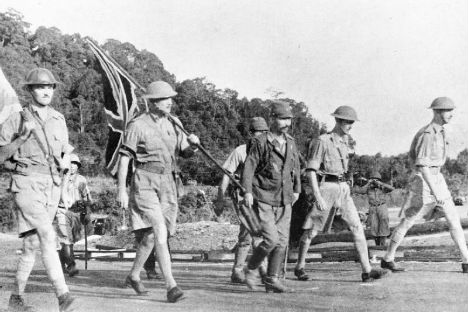
British surrender at
Singapore
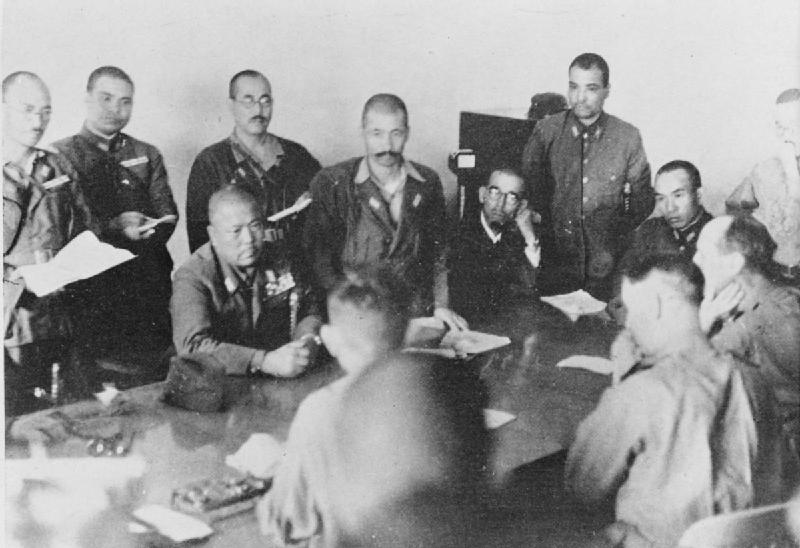
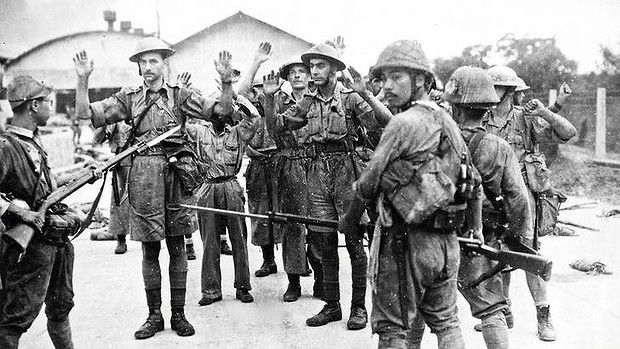
An unprepared America is humiliated in the Philippines
|
The fall of the Philippines
The Philippines, where some 12,000 American troops
were located, lay directly at the center of the Japanese path of
conquest. Under fierce Japanese attack, the surprised Americans and
their Filipino allies retreated into a fairly defensible land position
on the Bataan peninsula and the island fortress of Corregidor – but
found that the Japanese had cut off the surrounding sea routes from
which they might draw resupply. Food and ammunition eventually ran out.
First at Bataan in April and then finally at Corregidor in early May, after nearly five months of hopeless struggle, the Americans and Filipinos there had to surrender. The Japanese, already contemptuous of the Americans and Filipinos as fighters, became even more contemptuous of them when they surrendered – forcing some of them to march sixty miles without food or water to a prison camp at Bataan. Thousands1 of American and Filipino troops died along the way – with even more dying soon after arriving at the prison camp. The Japanese were at this point already famous for their cruel treatment of their enemies. But news of all this spun America into an intense fury. Nonetheless for the time being there was little America could do – because the country was still very unprepared for war. 1Figures
vary widely, from 2,500 to 10,000, because many of the Filipinos were
able to escape along the way, affecting the count. Also, the original
number of prisoners is not known with any precision, varying from
60,000 to 80,000 in the best estimates.
|
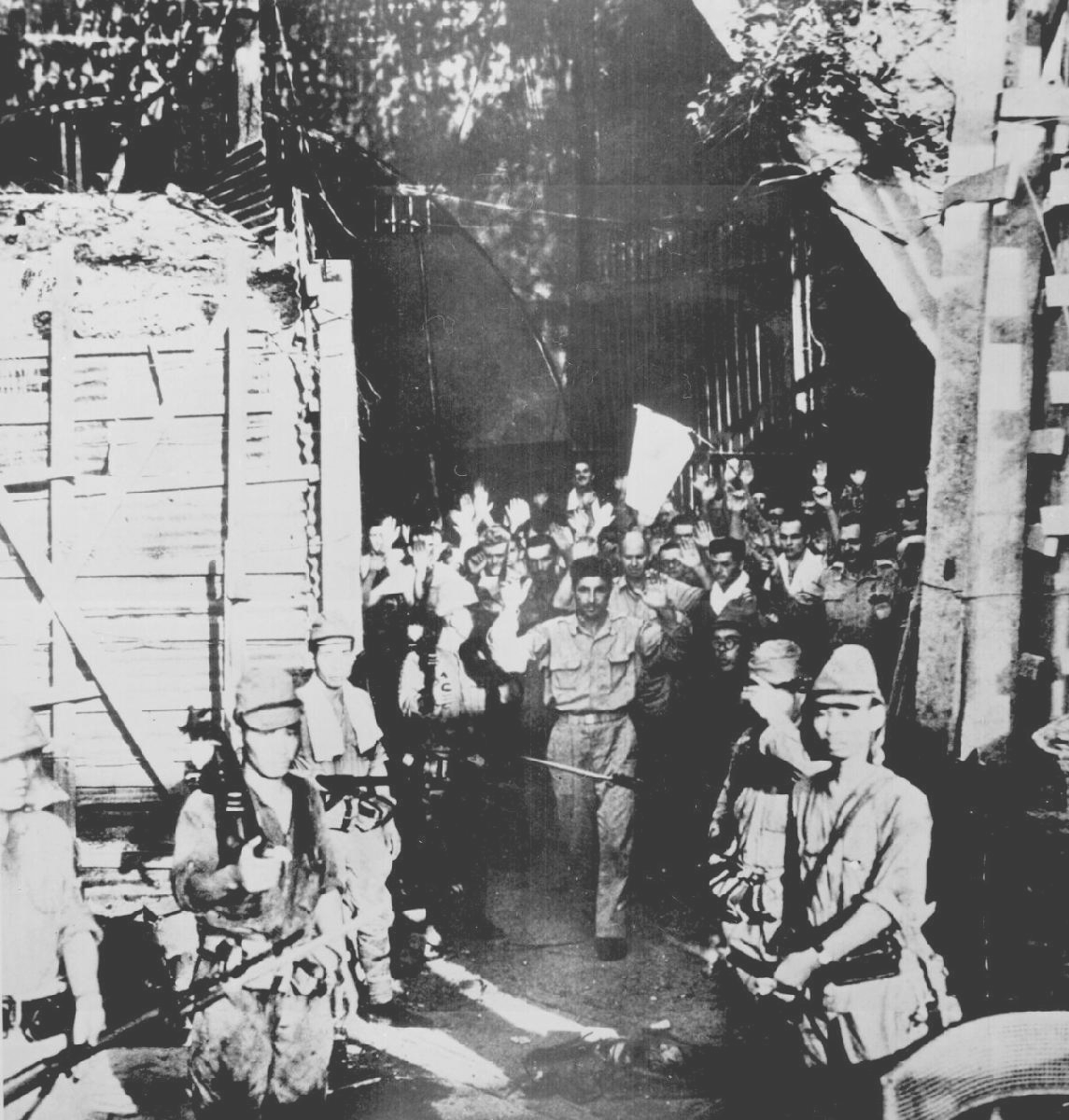
Surrender of American troops at Corregidor,
Philippine Islands, May 1942
National Archives
208-AA-80B-1
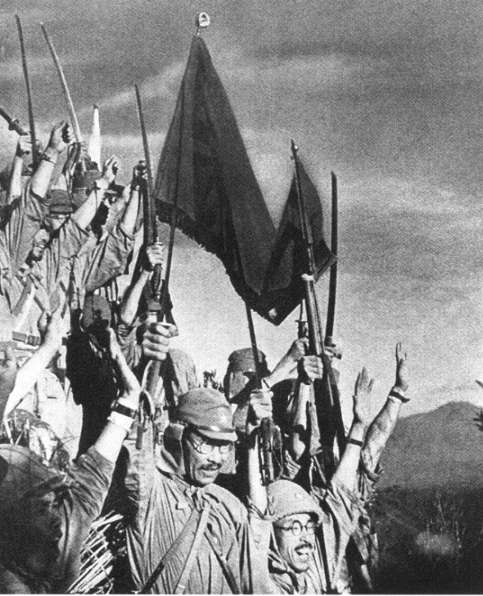
Japanese banzai
(hurrah)
for victory in a 5-month siege
against the Americans and
Filipinos in the Philippines
U.S. Army
Some of the 12,000 GIs
and
64,000 Filipino soldiers who surrendered to the Japanese at
Bataan – May
1942. They were forced to take up a 65-mile march without water and in the
tropical heat to a POW camp. Some 10,000 escaped en route – but 6,500 died along the way.
Another 17,000 died in Japanese
POW camps.
Americans
surrendering to
the Japanese at Bataan – May 1942
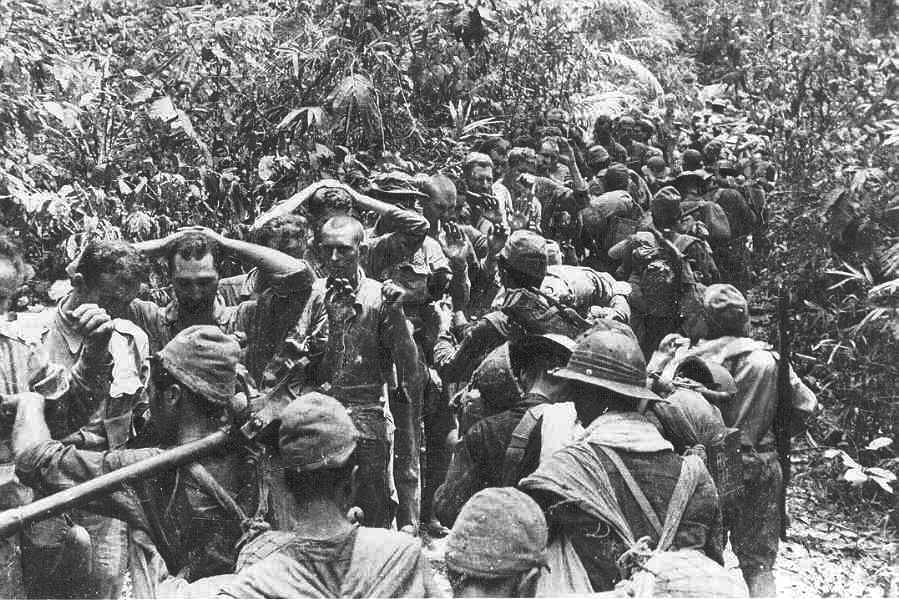
American troops
on the "Death
March" after a month-long siege on Corregidor Island – May
1942
"The March of Death. Along the March
[on which] these prisoners were photographed,
they have their hands tied behind their
backs. The March of Death was about May 1942,
from Bataan to Cabanatuan, the prison
camp."
"This picture, captured from the
Japanese,
shows American prisoners
using improvised litters to carry those
of their comrades who,
from the lack of food or water on the
march from Bataan, fell along the road."
Philippines, May
1942.
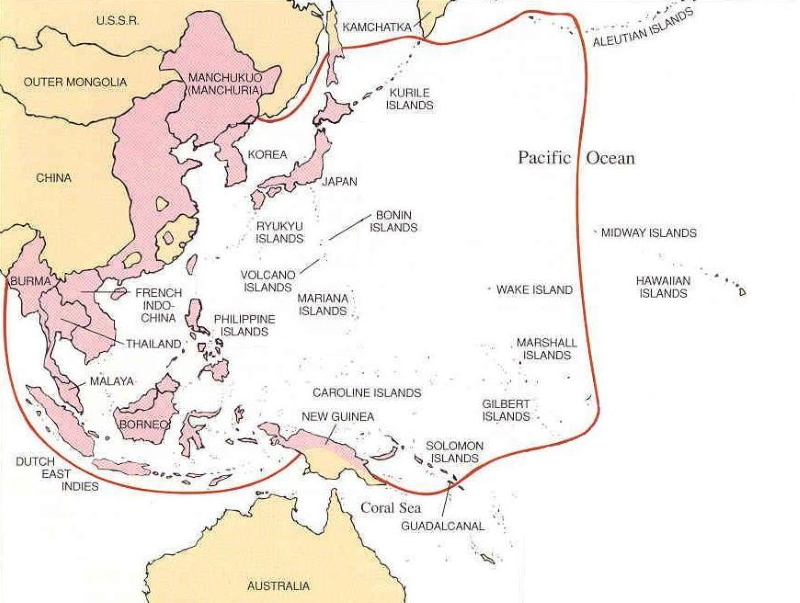
The Japanese Empire at its height –
1942

|
|
In the meantime, America took an action to give notice to the Japanese that the attack on Pearl Harbor did not produce the cowering of America as they had expected. In April sixteen B-25 bombers, led by Lieutenant Colonel James H. Doolittle, flew from the aircraft carrier Hornet to bomb Tokyo and other Japanese cities – more a symbolic hit than a serious military strike. Their bombing was not terribly devastating – but achieved its psychological objective. All the planes crashed (ran out of fuel) before reaching their destinations in China. But the crews of fourteen of the planes eventually made it back to America.
|
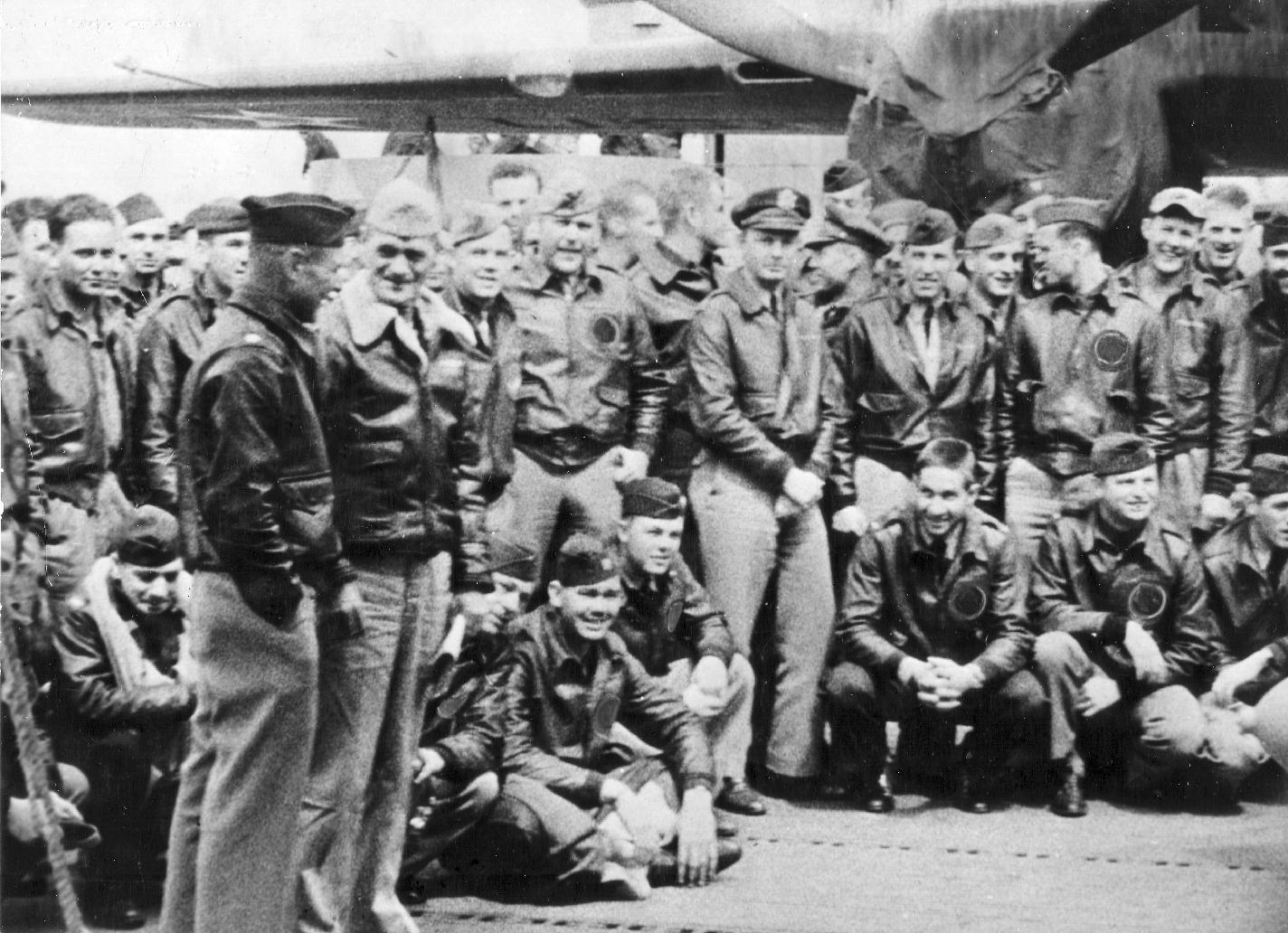
Lt. Col James Doolittle,
leader of the raid,
talks with Navy Captain Marc Mitscher,
skipper of the USS Hornet
U.S.
Navy
National Museum of the U.S. Air Force
"Take off from the deck of the USS HORNET
of an Army B-25 on its way to take part
in first U.S. air raid on Japan." Doolittle
Raid, April 1942.
National Archives
80-G-41196

|
|
Then in early May, Americans, having cracked the Japanese code, learned of a pending attack on Australia and sent four aircraft carriers2 to intercept this Japanese move. And thus the Battle of the Coral Sea took place. Both sides took hits, although Japan claimed to its people that it had been a grand Japanese victory. But in fact it completely halted all Japanese advance to the south. 2They
had been out on a training mission at the time of the bombing of Pearl
Harbor, thus avoiding destruction like the rest of America’s Pacific
Fleet.
|
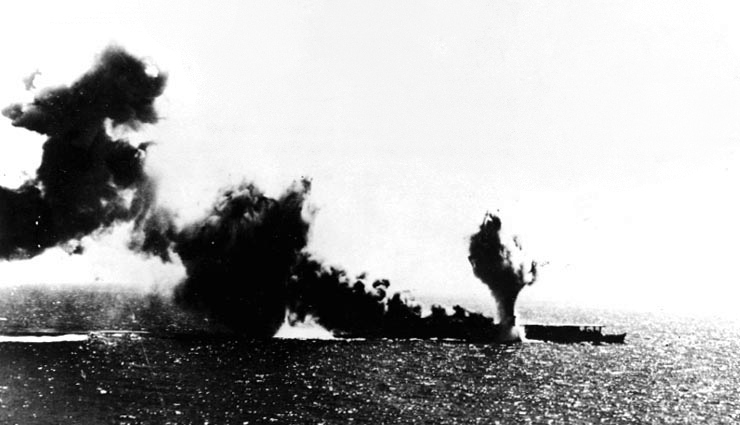
The Japanese
aircraft carrier Shoho, torpedoed
at the Battle of the Coral Sea
U.S.
Navy
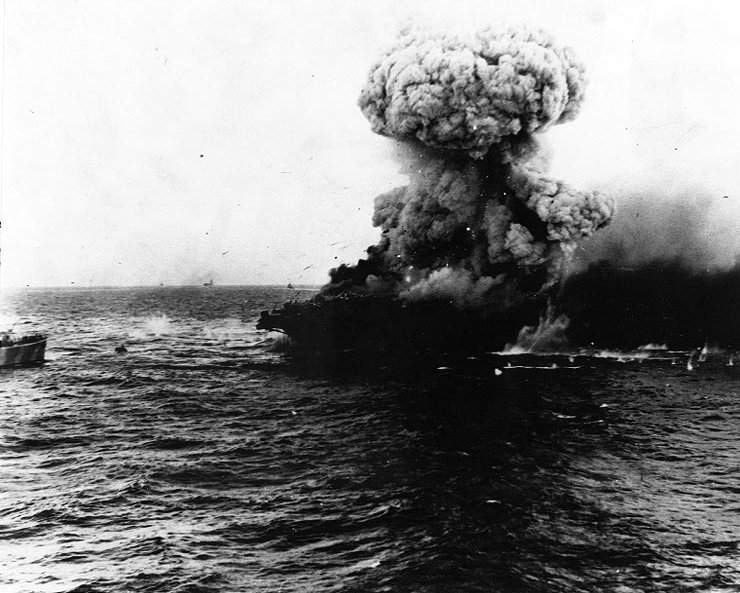
A "mushroom
cloud" rises
after a heavy explosion on board USS Lexington (CV-2), 8 May
1942.
This is probably the "great
explosion" from the detonation of torpedo warheads stowed in
the starboard
side of the hangar, aft, that
followed an explosion amidships at 1727 hrs.
Note USS Yorktown
(CV-5) on the horizon in the left
center, and destroyer USS Hammann
(DD-412) at the extreme
left.
The Lexington, burning and sinking after the Battle of the Coral Sea

|
|
Then even more amazingly, again aware of Japanese intentions, in June these same aircraft carriers headed north to the Central Pacific island of Midway which the Japanese were hoping to capture as a base from which attacks on America’s west coast could be launched. They were not expecting to find these aircraft carriers there, were caught completely off guard, and were badly mauled by American aircraft launched from these carriers. The Japanese loss was so big (but again they presented it to their people as another great win) that not only was their expansion east across the Pacific halted, but this marked the beginning of the Japanese retreat in the Pacific.
|
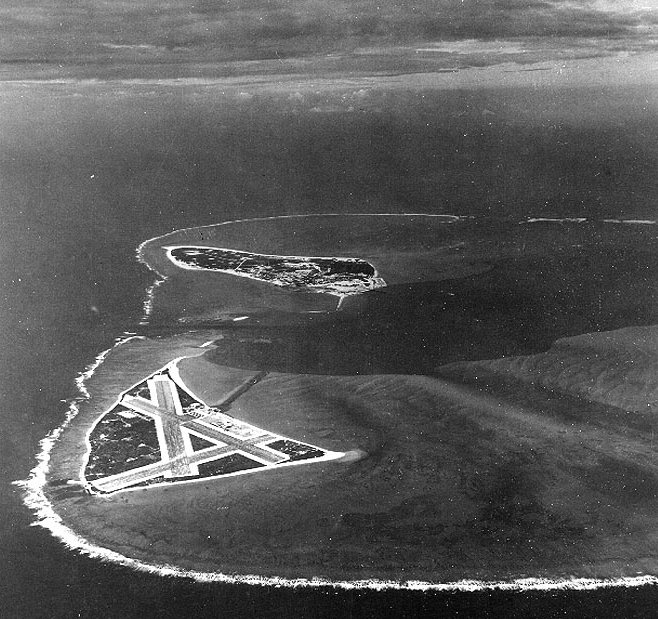
Midway
Atoll, looking just south of
west across the southern side of the atoll, November
1941.
Eastern Island, then the
site of Midway's airfield, is in the foreground.
Sand Island, location of
most other base facilities, is across the entrance channel.
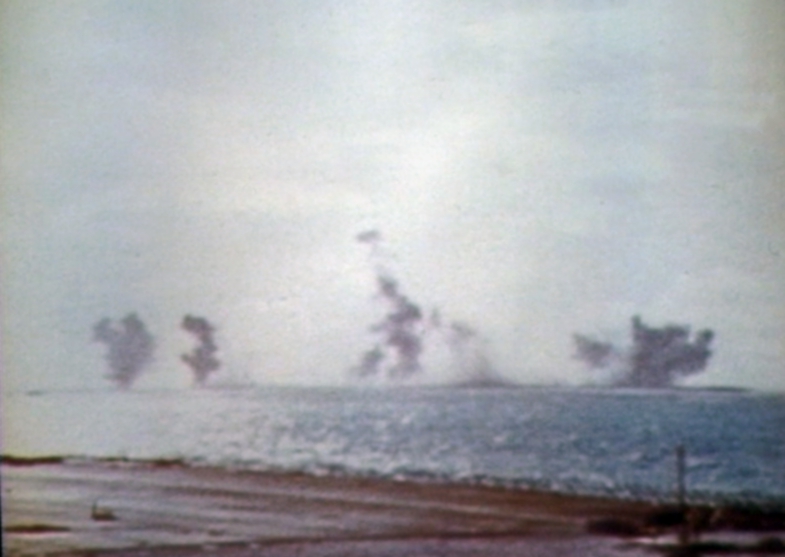
Eastern Island,
Midway Islands,
under attack, 4 June 1942
U.S. Navy
| 3 Japanese carriers were sunk in the opening rounds of the battle; 2 days later a Japanese submarine finished off the crippled Yorktown – but the Japanese lost another carrier – and a total of 332 planes. This huge Japanese loss at Midway effectively ended their dominance in the Pacific. |
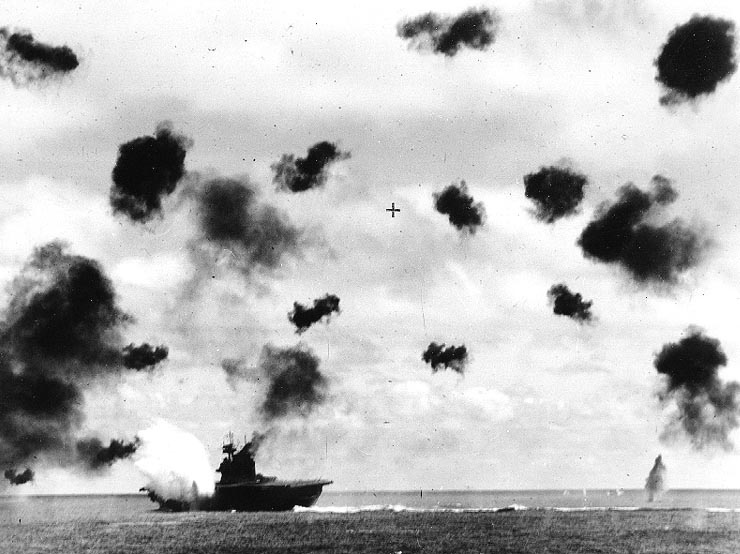
USS Yorktown is
hit by an
aerial torpedo – Midway, June 4, 1942
U.S. Navy
| "USS
Yorktown (CV-5)
is hit on the port side, amidships, by a Japanese Type 91 aerial torpedo
during the mid-afternoon attack by planes from the carrier Hiryu,
in the Battle of Midway, on June 4, 1942. Photographed from USS Pensacola
(CA-24). Yorktown is heeling to port and is seen at a different
aspect than in other views taken by Pensacola, indicating that this
is the second of the two torpedo hits she received. Note very heavy anti-aircraft
fire."
Though badly damaged, she survived this attack. But as she was making her way back for repairs, she was sunk by a Japanese submarine on June 7. |
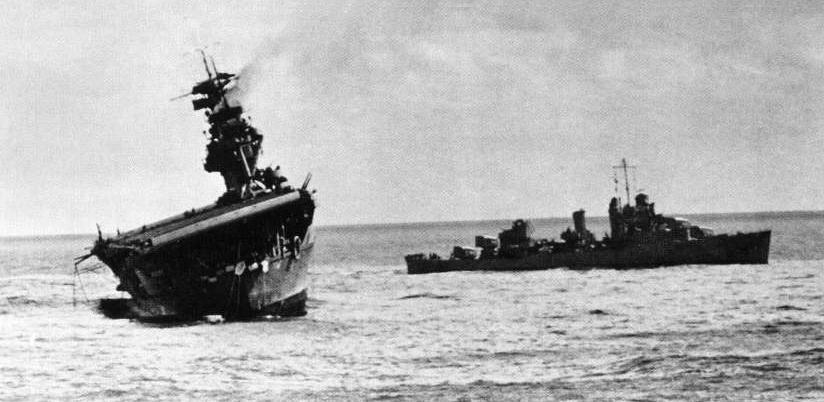
The aircraft
carrier USS
Yorktown listing heavily from a Japanese torpedo hit at Midway – June
4, 1942
U.S.
Navy
The burning
Japanese aircraft
carrier Hiryu, photographed by a plane from the carrier Hosho
shortly after sunrise on 5 June 1942. Hiryu sank a few
hours
later. Note collapsed flight deck
over the forward hangar.
U.S. Navy National Museum
of Naval Aviation
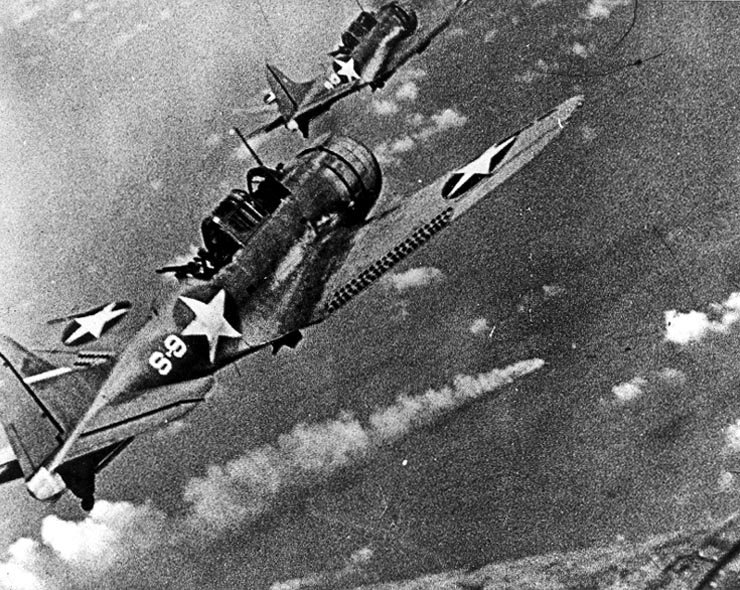
U.S. Douglas
SBD Dauntless
dive bombers about to attack the burning cruiser Mikuma
for the
third time.
U.S. Navy – National
Archives
| "'Dauntless' dive bombers from USS Hornet (CV-8) approaching the burning Japanese heavy cruiser Mikuma to make the third set of attacks on her, during the Battle of Midway. Mikuma had been hit earlier by strikes from Hornet and USS Enterprise (CV-6), leaving her dead in the water and fatally damaged." |
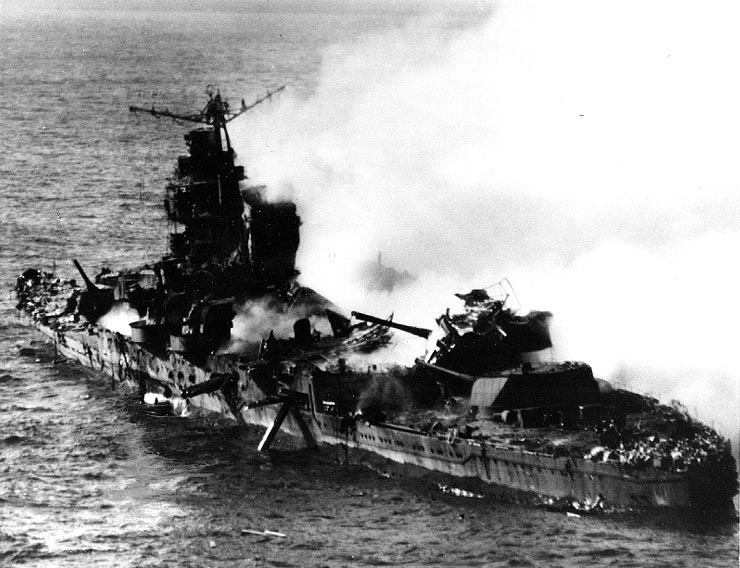
Mikuma shortly
before sinking.
- west of Midway, June 6, 1942
U.S. Navy – National
Archives
| "Japanese heavy cruiser Mikuma, photographed from a USS Enterprise (CV-6) SBD aircraft during the Battle of Midway, after she had been bombed by planes from Enterprise and USS Hornet (CV-8). Note her shattered midships structure, torpedo dangling from the after port side tubes and wreckage atop her number four eight-inch gun turret." |
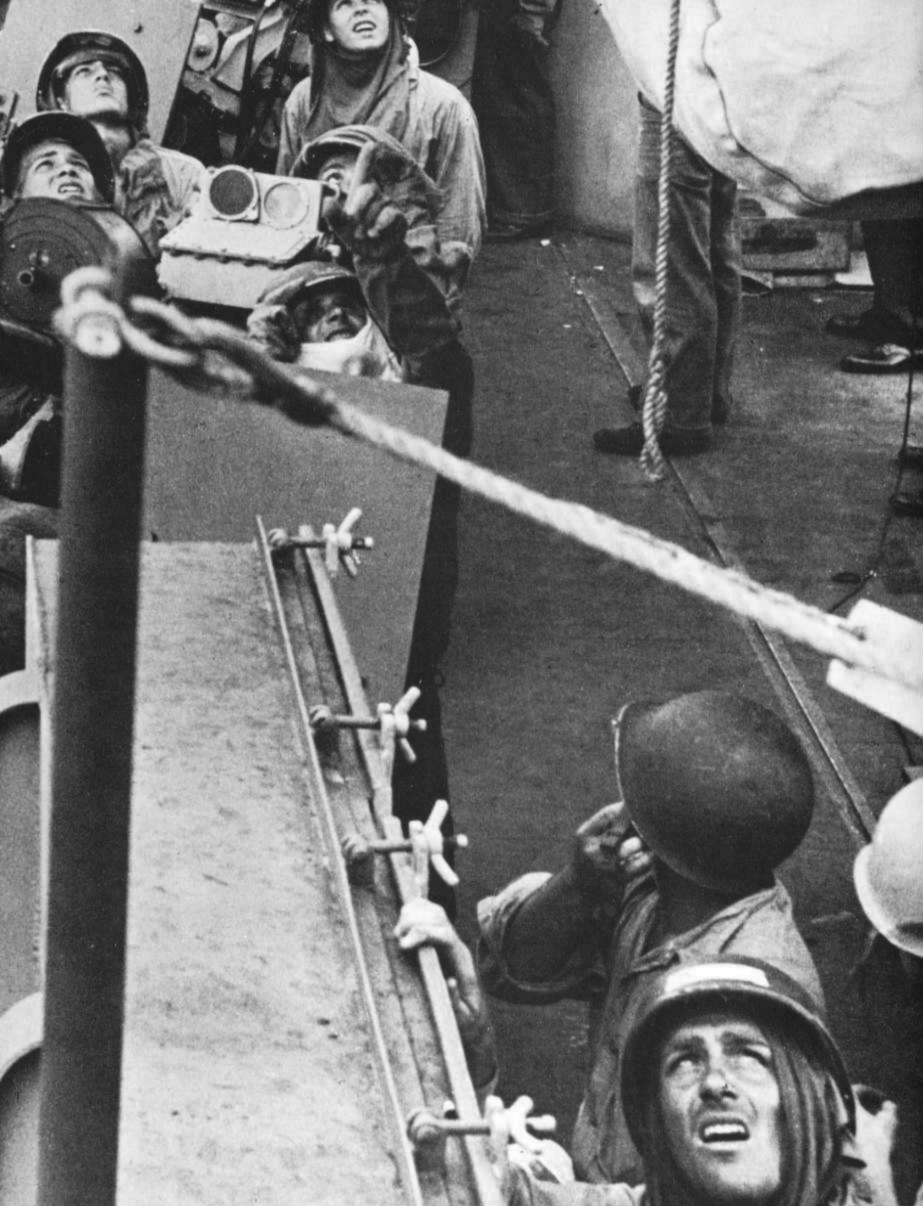
Crewmen on the
US carrier
Hornet
watching approaching Japanese planes
United States
Navy
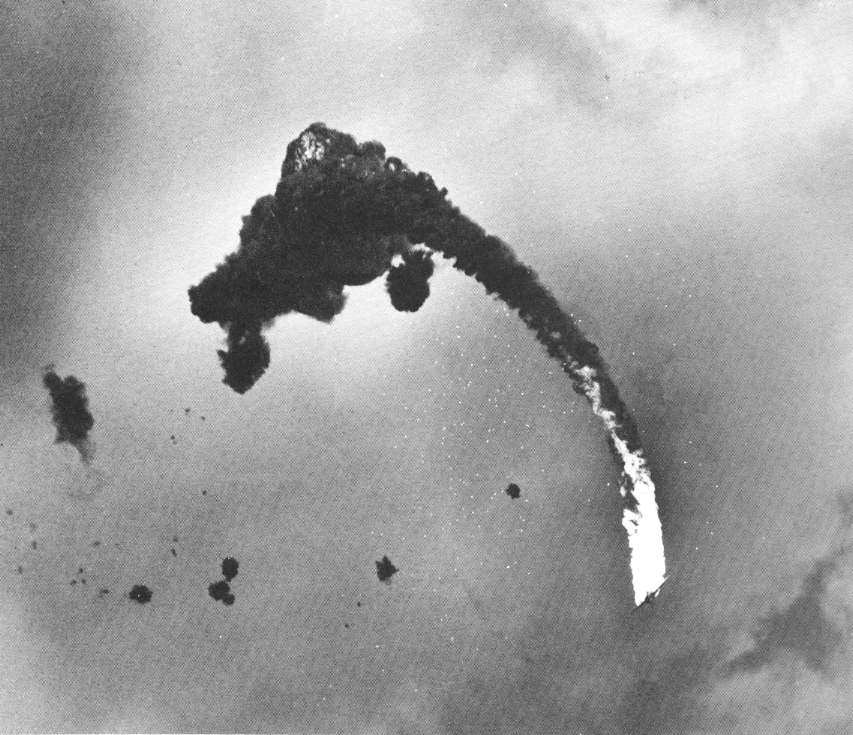
A Japanese
bomber hit by
artillery fire from the Hornet
United States
Navy

|
|
The roll-back of the Japanese Empire in the Pacific
Now it would be a matter of capturing island after island. Actually, this involved American "island hopping" or bypassing islands held by the Japanese, (who at this point would then find themselves isolated) and assaulting only those islands with aircraft bases – or with the potential for such. The huge island of Guadalcanal in the South Pacific did not fall easily, taking from August of 1942 to February of 1943 to fully secure – against the Japanese tendency when faced with obvious defeat to simply conduct suicide runs (banzai charges) against American machine guns, rather than accept the humiliation of surrender. The Japanese military code of bushido demanded nothing less of its soldiers – and eventually even of its civilians. All of this slaughter of countless Japanese unnerved the American soldiers greatly. But it was a job that had to be done.
|
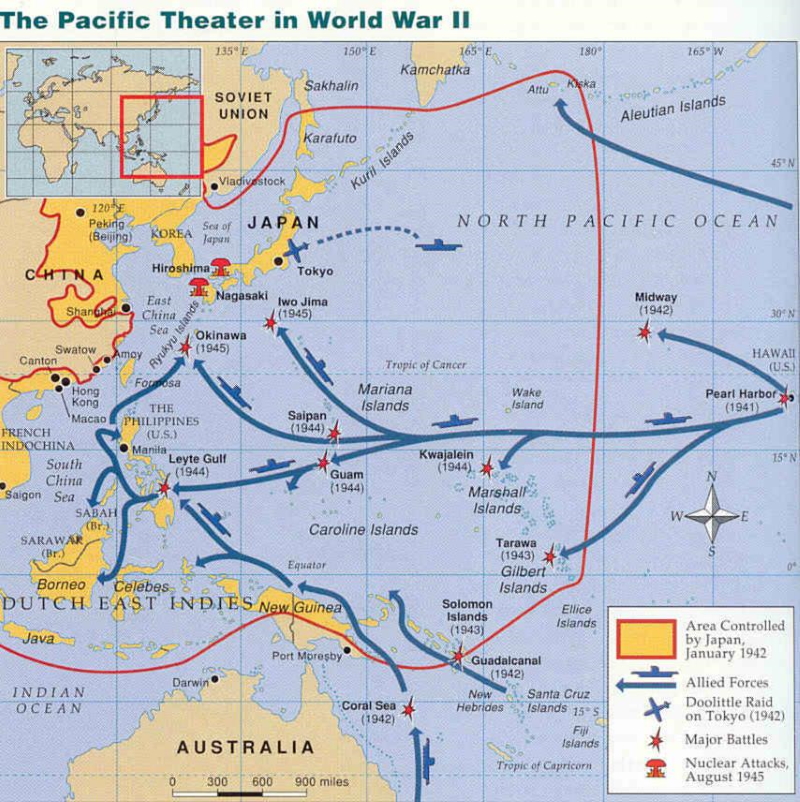
Peck and Deyle, p. 626
The Advance
against
Japan
Evans, pp.
322-323
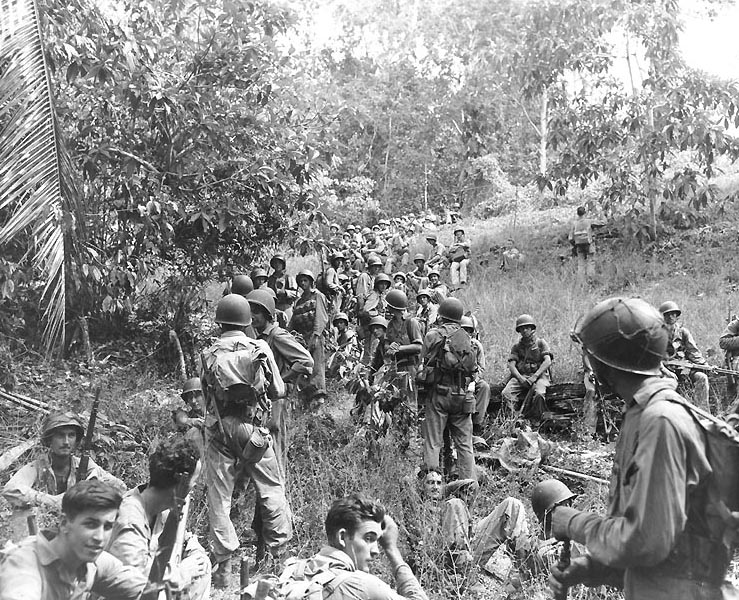
U.S. Marines rest in the field on Guadalcanal, circa August-December 1942
GIs slogging
their way forward
against the Japanese at Guadalcanal – 1942
GIs washing up on Guadalcanal
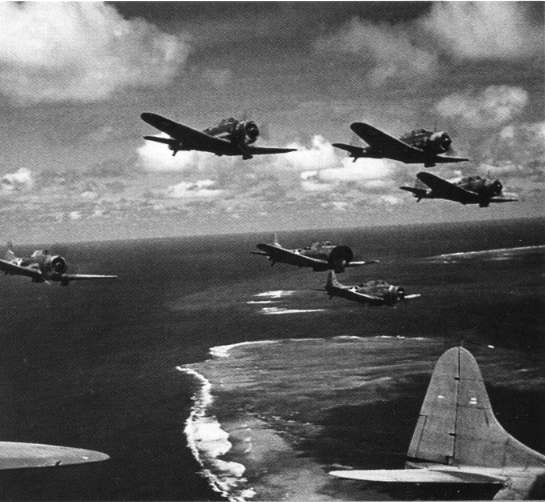
Carrier-based US
torpedo
bombers and fighters
in formation for an attack
on the Japanese fleet
"A Chinese soldier guards a
line
of American P-40 fighter planes, painted with the shark-face
emblem of the 'Flying Tigers,' at a
flying field somewhere in China." ca. 1942.
"Officer at periscope in control room
of submarine." ca. 1942
Torpedoed Japanese destroyer photographed
through periscope
of U.S.S. Wahoo or U.S.S. Nautilus,
June 1942
The Aleutians were intended
to come under Japanese assault simultaneously with
the attack on Midway Island.
But the Aleutian assault proved to be a dud.
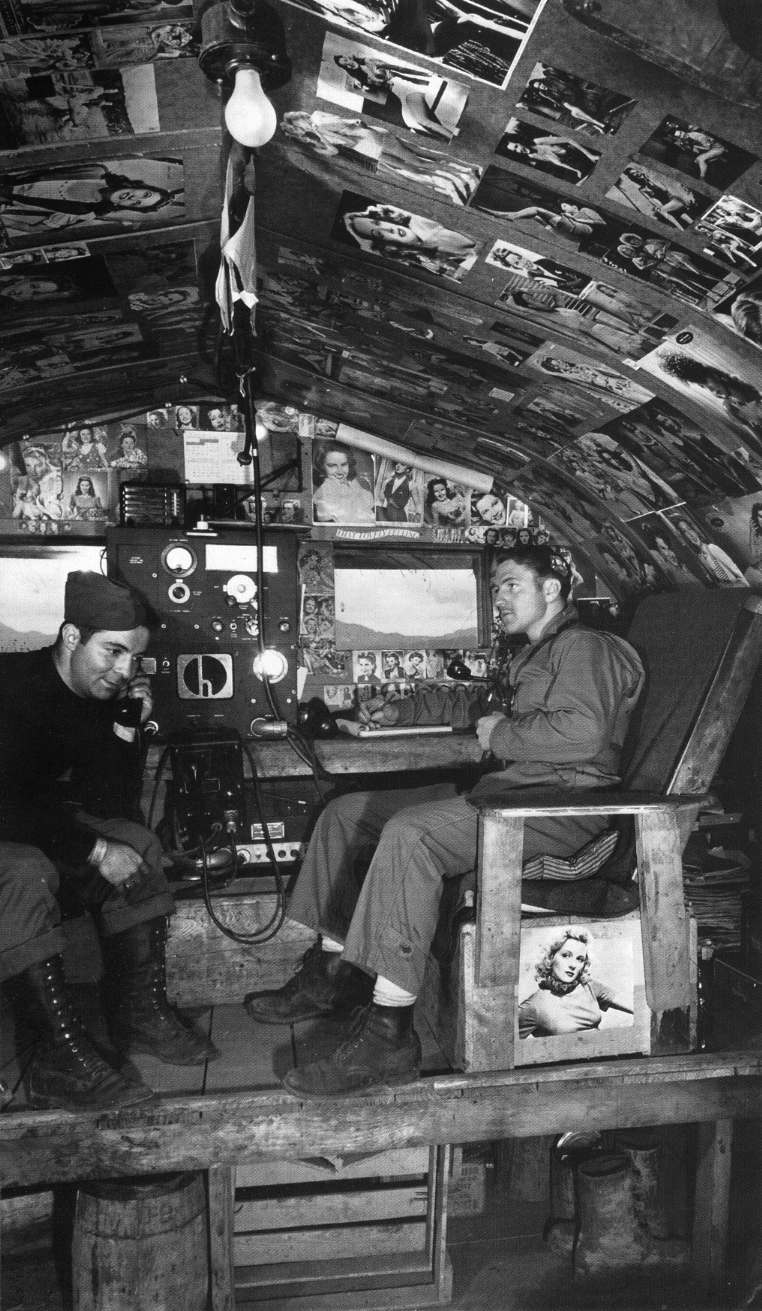
US airmen
posted to the Aleutians
relaxing inside a well-decorated hut
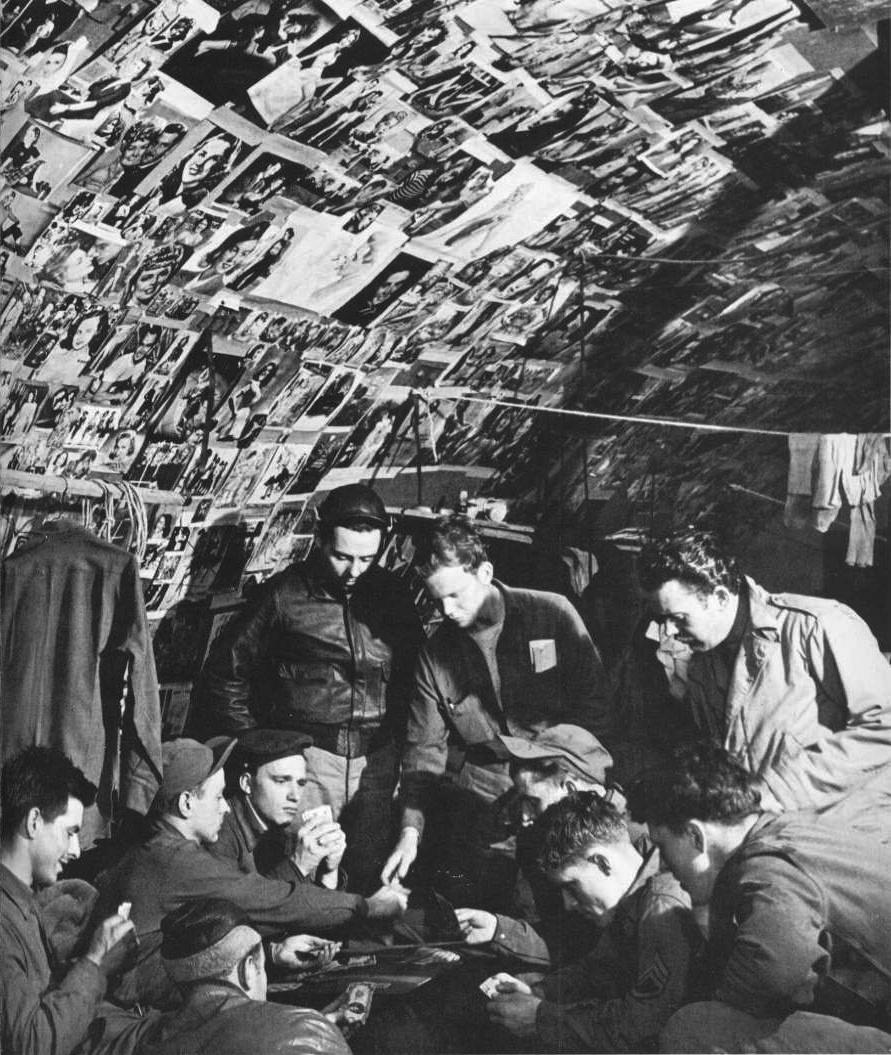
Airmen relaxing
in their
quonset hut in the Aleutians
What it was that kept the boys warm

Rita
Hayworth
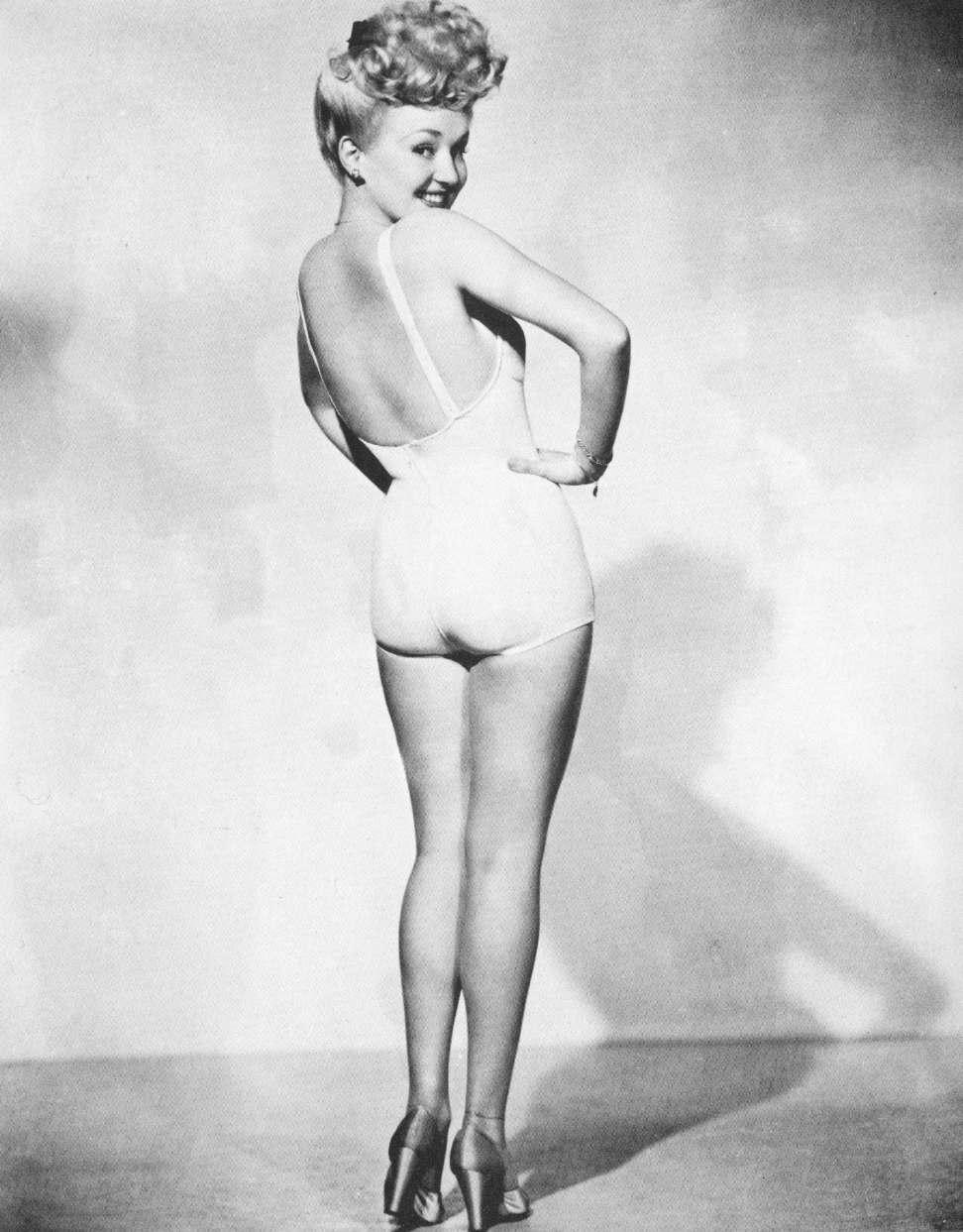
Betty
Grable

|
|
So, up from New Guinea Americans moved, launching the offensive at Buna Beach (where in January of 1943 photographers were allowed for the first time to take pictures of the war casualties on both sides) and from the Solomon Islands at Bougainville (taking from November 1943 to February 1944 to secure), making their way under General MacArthur’s command towards the Philippine Islands. Finally in October (1944) they were able to land on the Philippine Island of Leyte and the following January (1945) to the shores of Luzon, from which they then advanced on the Philippine capital Manila – which got heavily damaged in its liberation, occurring finally in late February.
|
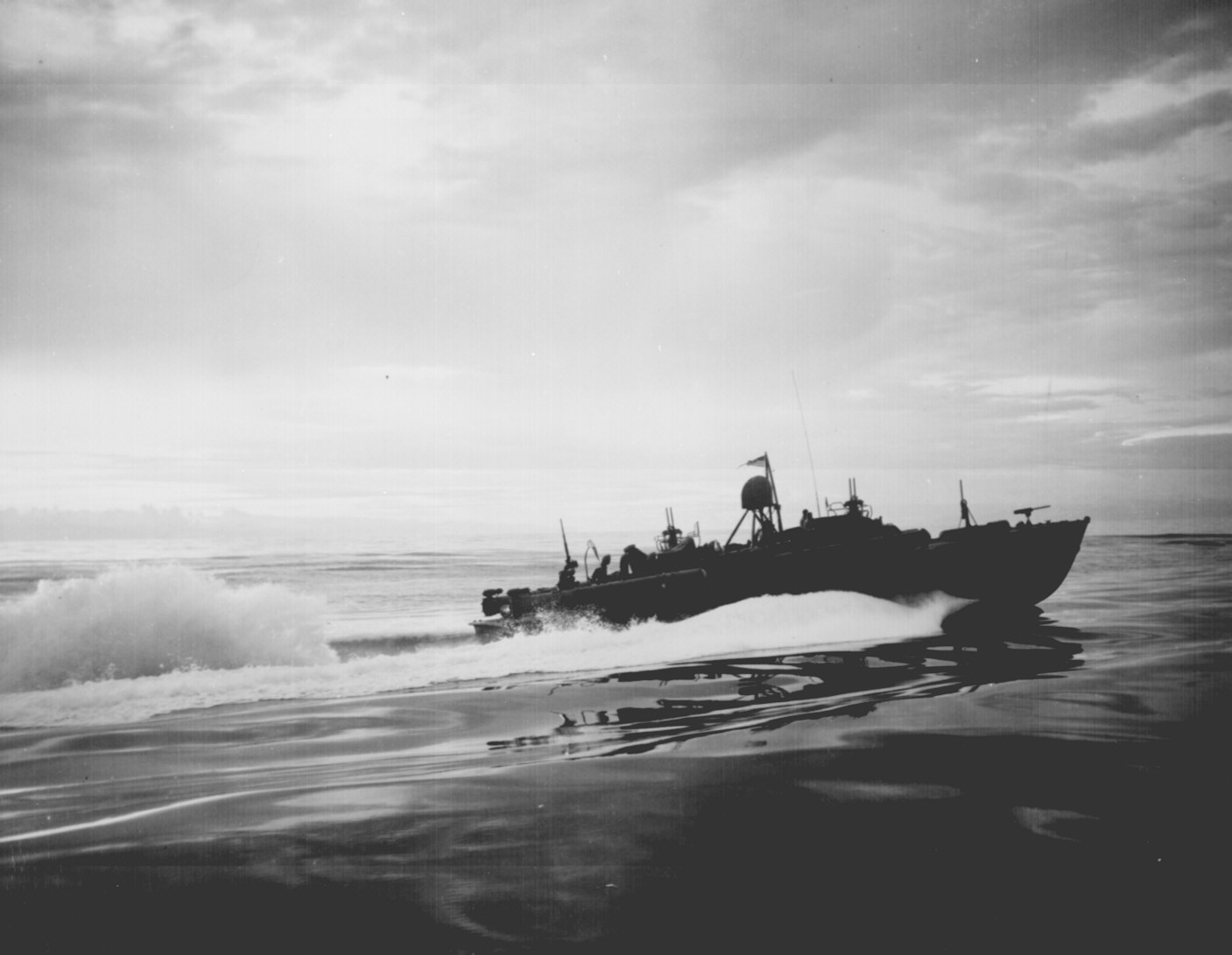
"PT's patrolling off coast of New Guinea."
1943
"A PT marksman provides a striking
camera
study as he draws a bead
with his 50 caliber machine gun on
his boat off New Guinea." July 1943
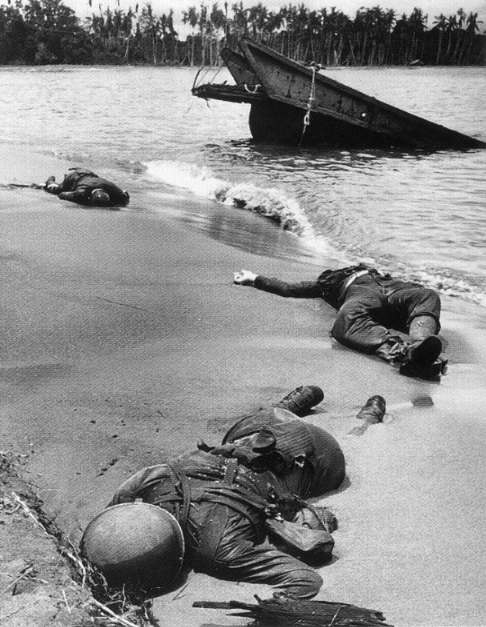
GIs killed along
Buna beach
in New Guinea – January 1943
A dead GI
washed in by the
tide at Buna beach
A GI inspecting
Japanese
killed at Buna Beach – Jan. 1943
Doctors digging
shrapnel
from a GI's back in a field hospital
The Solomon Islands – Bougainville (late 1943 – early 1944)
"Landing operations on Rendova Island,
Solomon Islands, 30 June 1943.
Attacking at the break of day in a
heavy rainstorm, the first Americans ashore
huddle behind tree trunks and any other
cover they can find."
"Crewmen lifting Kenneth Bratton out
of turret of TBF on the USS SARATOGA
after raid on Rabaul." Lt. Wayne Miller,
November 1943
"U.S. troops go over the side of a Coast Guard manned combat transport to enter the
landing barges at Empress Augusta Bay, Bougainville,
as the invasion gets under way."
November 1943.
"Dynamic static. The motion of its props
causes an `aura' to form around this F6F on
USS YORKTOWN. Rotating with
blades, halo moves aft, giving depth and perspective."
November 1943.
"U.S. Marine "Raiders" and their dogs,
which are used for scouting and running
messages,
starting
off for the
jungle front lines
on Bougainville."
T.Sgt. J. Sarno,
ca.
November/December 1943.
"In an underground surgery room, behind
the front lines on Bougainville, an American Army doctor
operates on a U.S. soldier
wounded by a Japanese sniper."
December 13, 1943.
"Invasion of Cape Gloucester, New Britain,
24 Dec. 1943. Crammed with men and
material
for the
invasion,
this Coast Guard-
manned LST nears the Japanese held
shore.
Troops
shown in
the picture are Marines."
PhoM1c. Don C. Hansen.
"Marines hit three feet of rough water
as they leave their LST to take the beach at
Cape Gloucester, New
Britain." Sgt.
Robert M. Howard, December 26, 1943.
"Retreating at first into the jungle
of Cape Gloucester, Japanese soldiers
finally gathered strength and counterattacked their
Marine pursuers.
These machine gunners pushed
them back." January 1944.
U.S. Soldiers at
Bougainville
(Solomon Islands) March 1944
"The Yanks mop up on Bougainville.
At night the Japs would infiltrate American
lines. At Dawn, the doughboys
went out and killed them. This photo shows
[M4 Sherman] tank going forward,
infantrymen following in its cover." March 1944.
May 1, 1944. Members of the
US 93rd (93d) Infantry Division, the first African American infantry
unit to see action
in World War II, on the Numa-Numa Trail, Bougainville
"American troops of the 163rd
Infantry
Regiment hit the beach from Higgins boats during
the invasion of Wadke Island, Dutch
New Guinea." Lt. Kent Rooks, May 18, 1944.

|
|
At the same time, coming across the Pacific from the east, under the command of Admiral Chester W. Nimitz, the island of Tarawa was secured finally in November of 1943 – again at the great cost in human lives on both sides of the battle, although the Japanese suffered far worse in the process.3 From there they jumped to Kwajalein and Eniwetok (securing those islands in February of 1944) and then on to Guam (secured in August of 1944). From here they were close enough to Japan they could now conduct relentless bombing of the Japanese heartland itself. 3Debate
would be ongoing even till today as to whether or not it was absolutely
necessary to spill American blood to seize this off-path objective.
|
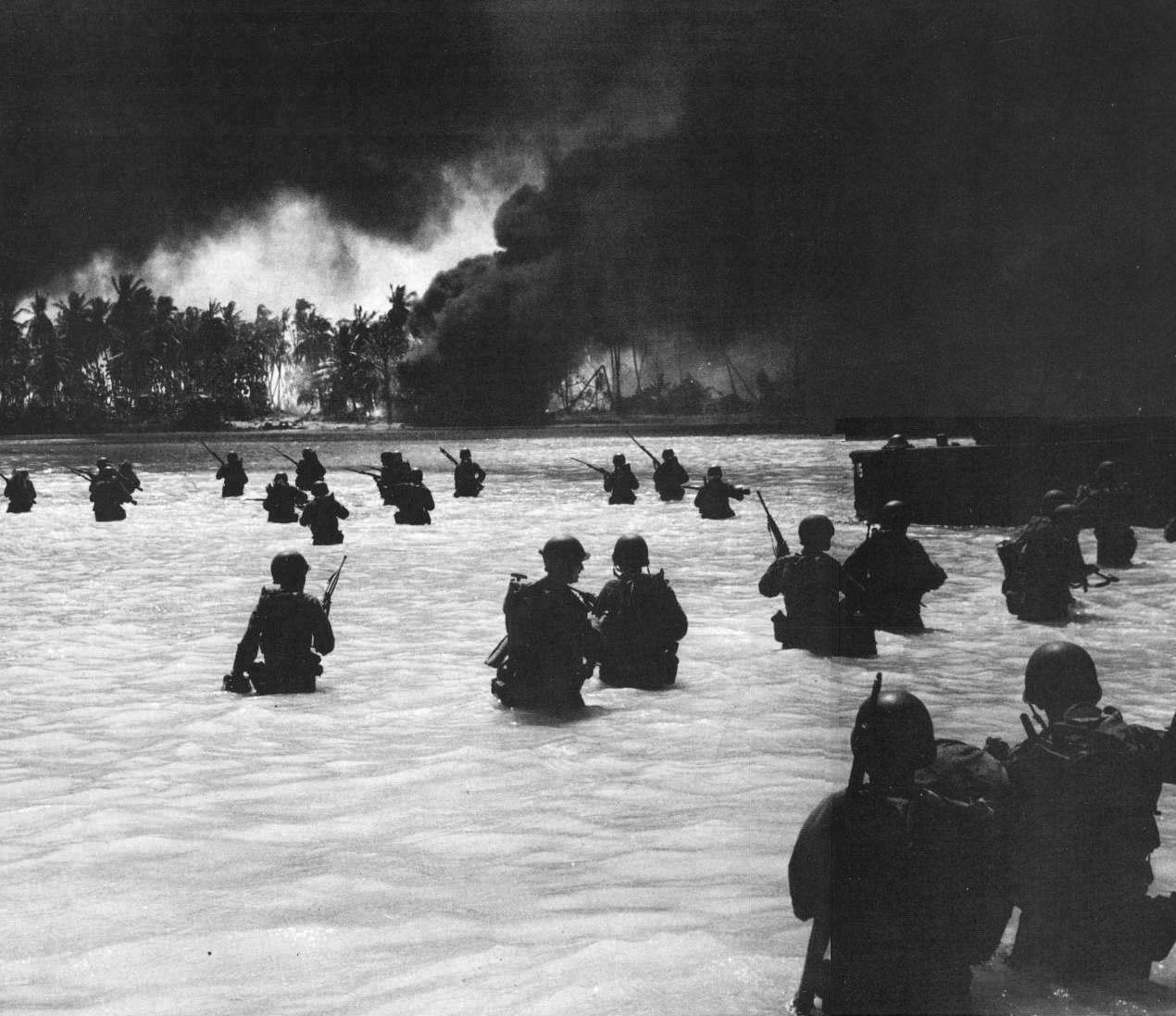
"165th Infantry assault wave attacking
Butaritari, Yellow Beach Two,
find it slow going in the coral bottom
waters. Jap machine gun fire from the right flank
makes it more difficult for them." Dargis,
Makin Atoll, Gilbert Islands, November 20, 1943
"Marines storm
Tarawa. Gilbert
Islands."
WO Obie Newcomb, Jr.,
November
1943
"Sprawled bodies
on
the beach at Tarawa,
testifying to ferocity of
the struggle for this stretch of sand" – November
1943
Two enlisted men of the
ill-fated U.S.
Navy aircraft carrier LISCOME BAY,
torpedoed by a
Japanese submarine in
the Gilbert Islands, are buried at sea from the deck
of a Coast
Guard-manned assault transport."
November 1943.
In from the East and heading
west toward Japan:
The Marshall Islands – Kwajalein
and Eniwetok (early 1944)
"Jap torpedo bomber explodes
in air
after direct hit by 5 inch shell from U.S. aircraft carrier
as it attempted
an
unsuccessful attack
on carrier, off Kwajalein." U.S.S. Yorktown.
CPhoM. Alfred N. Cooperman, December
4, 1943.
"Pilots pleased
over their
victory during the Marshall Islands attack, grin across the tail of an F6F
Hellcat on
board the USS Lexington, after shooting down 17 out of 20 Japanese planes heading
for Tarawa."
By Comdr.
Edward J. Steichen, November 1943
"Men of the 7th Division using
flame
throwers to smoke out Japs from a block house on
Kwajalein Island,
while others wait with
rifles ready
in case Japs come out."
Cordray, February 4,
1944.
"Back to a Coast Guard
assault transport
comes this Marine
after two days and
nights of Hell on
the beach of Eniwetok in the Marshall Islands.
His face is grimey
with coral dust
but the light of battle stays in his eyes." February 1944.

|
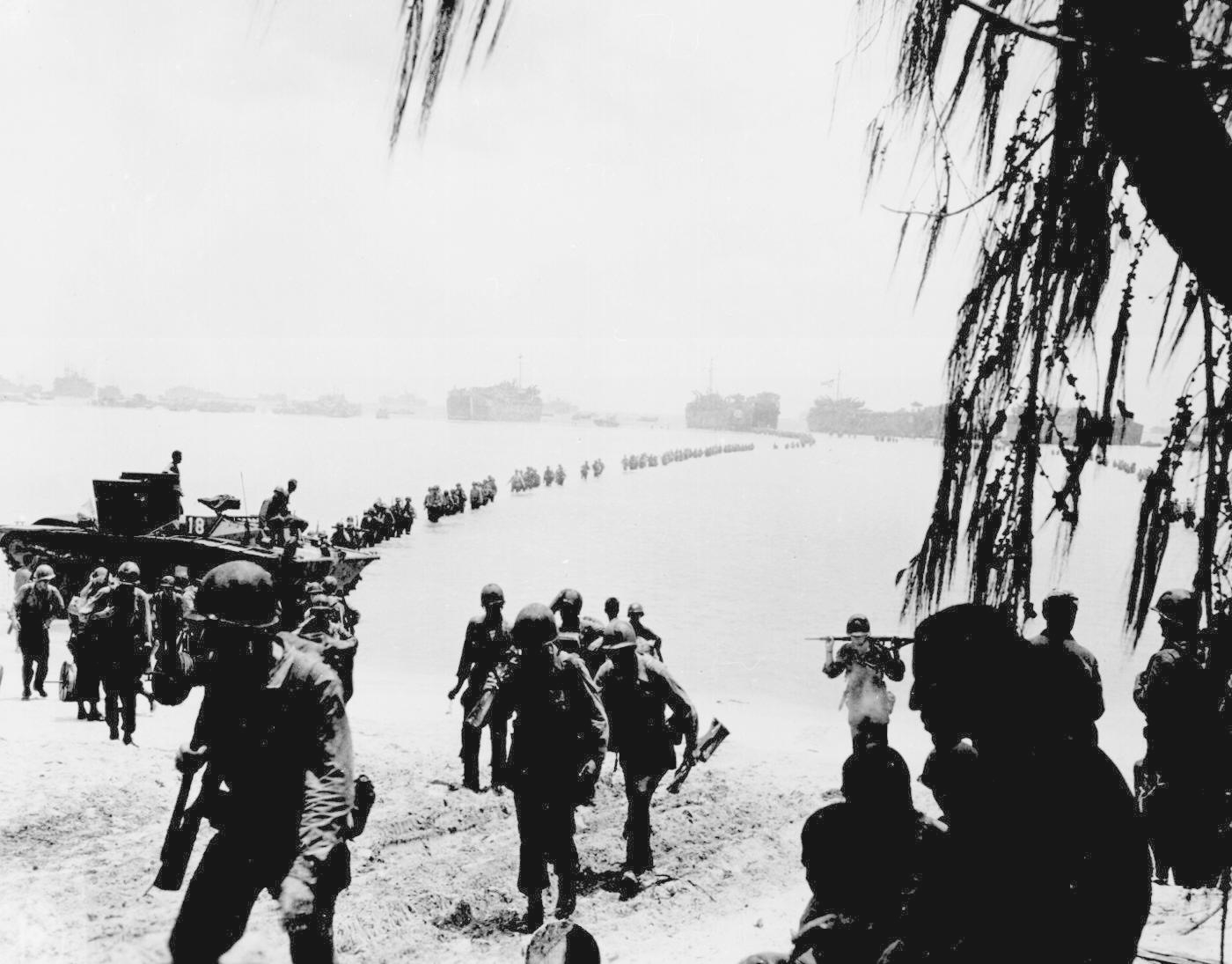
"Army reinforcements disembarking
from
LST's form a graceful curve as they proceed across
coral
reef toward the
beach."
Laudansky, Saipan, ca. June/July
1944.
With a canvas tarpaulin for a
church
and packing cases for an altar,
a Navy chaplain
holds
mass for Marines
at Saipan.
The service was
held
in memory of brave
buddies who lost their lives in the initial landings."
Sgt.
Steele, June 1944.
"After the Marines captured this
mountain
gun from the Japs at Saipan, they put it
into use
during the attack on
Garapan, administrative
center of the island."
Cpl. Angus Robertson, ca. July
1944.
"A Water Buffalo, loaded with Marines,
churns through the sea bound
for beaches of
Tinian Island
near
Guam." July 1944.
"First flag on Guam on boat hook mast.
Two U.S. officers plant the American flag on Guam
eight minutes after U.S. Marines
and
Army assault troops landed on the Central
Pacific island
on
July
20, 1944."
"The crew of the
USS South Dakota
stands with bowed heads,
while
Chaplain
N. D.
Lindner reads
the benediction held in honor of fellow shipmates
killed in the air
action
off Guam on
June 19, 1944." July 1, 1944.
"Marine Pfc. Douglas Lightheart
(right)
cradles his 30-cal. machine gun in his lap,
while he and
his buddy Pfc. Gerald
Churchby take time out for a cigarette,
while mopping up the enemy on
Peleliu
Is." Cpl. H. H. Clements, September 14,
1944.
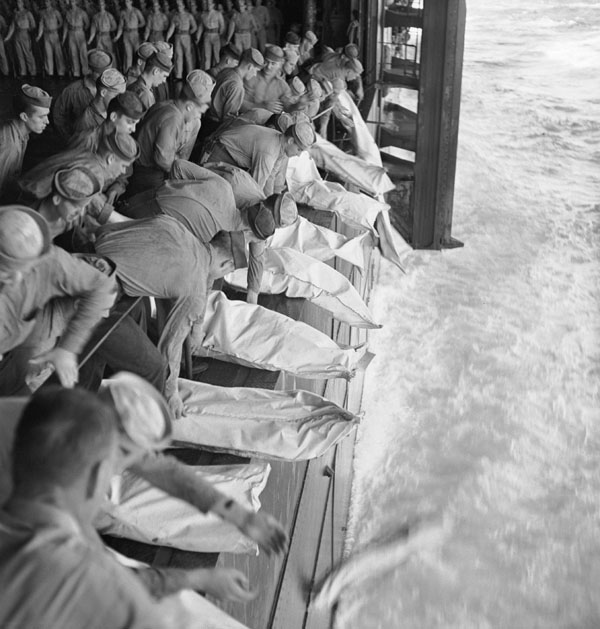
"Burial at sea for
the officers
and men of the USS Intrepid (CV-11) who lost their lives
when the carrier was hit
by Japanese bombs during operations in the
Philippines."
Lt. Barrett Gallagher,
November 26, 1944
While the war moves on, touches of home bring humor and comfort
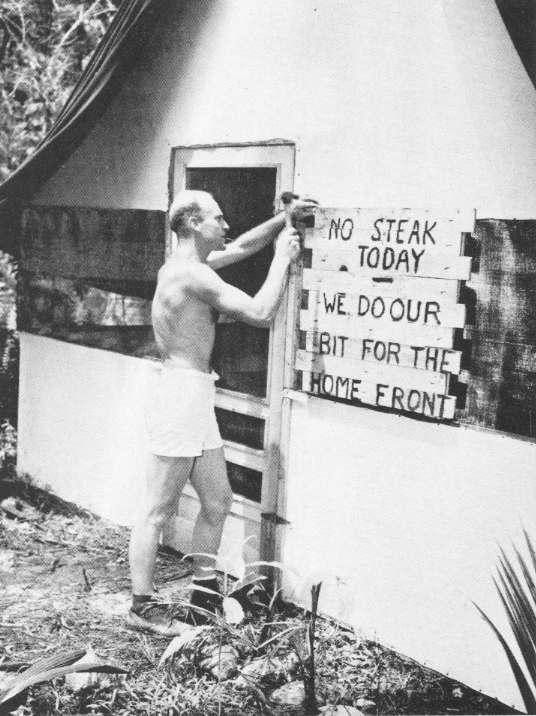
A mess sergeant
posting commentary
on the food rations available to him

|
Liberating the Philippines – beginning
with Leyte – and then advancing to Luzon
|
When they landed at Iwo Jima (mid-February of 1945) they were now on Japanese territory itself, and the defensive battle was murderous. By the time six weeks later they had secured the island, ninety per cent of the Japanese force of 20,000 was killed (or committed suicide) in the action. They were getting another example of how brutal the task of bringing Japan to surrender would be. This same experience was repeated in the taking of the Japanese island of Okinawa. This large island was so strongly defended that it took three months of battle to finally bring it under Allied control. The Japanese killed in action numbered fourteen times the Allies killed, a clear indicator of the Japanese resolve to fight to the death rather than surrender. What air action that the Japanese did offer at Okinawa was suicidal, a desperate effort of 4,000 young (and inexperienced) Japanese kamikaze pilots to hurl themselves and their explosives-laden planes at the American ships advancing on their islands. Only a small percentage were able to hit a ship. Nonetheless, the effort resulted in thirty ships sunk and over 300 others badly damaged by the fanatical kamikaze pilots. Nonetheless, the Japanese naval attack on the American fleet failed to stop the American advance. By now it was clear that the Americans were unstoppable. But it was also clear that the Japanese did not seem willing to give up the fight as long as there were any Japanese still alive to fight. Even the women and youth were being trained in defense tactics. It looked as if the Allies were going to have to go village to village across the entirety of Japan to finally bring the war with Japan to an end. This might take years and millions of casualties to complete.
|
"The gun crews of a Navy cruiser covering
American landing on the island of Mindoro,
Dec. 15, 1944, scan the skies in an
effort to identify a plane overhead.
Two 5'' (127mm) guns are ready while
inboard 20mm anti-aircraft crews are ready to act."
National Archives
80-G-47471.
"Two Coast Guard-manned LST's open their
great jaws in the surf that washes on
Leyte Island beach, as soldiers strip
down and build sandbag piers
out to the ramps to speed up unloading
operations." 1944.
National Archives
"USS PENNSYLVANIA and battleship of
COLORADO class followed by three cruisers
move in line into Lingayen Gulf preceding
the landing on Luzon." Philippines, January 1945.
National Archives
80-G-59525
"A line of Coast Guard landing barges,
sweeping through the waters of Lingayen Gulf, carries
the first
wave of invaders to the beaches of
Luzon, after a terrific naval bombardment of
Jap shore positions on Jan.
9, 1945." PhoM1c. Ted Needham.
National Archives
26-G-3856.
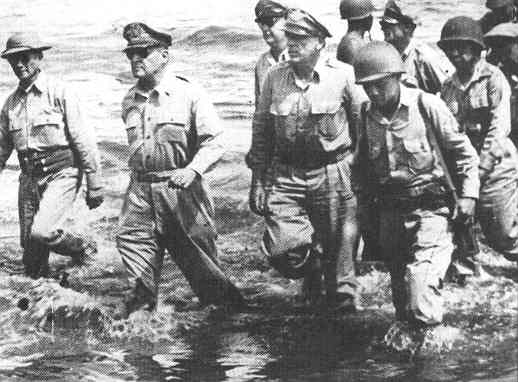
Gen. Douglas
MacArthur comes
ashore at Lingayen Gulf in the Philippines
National Archives
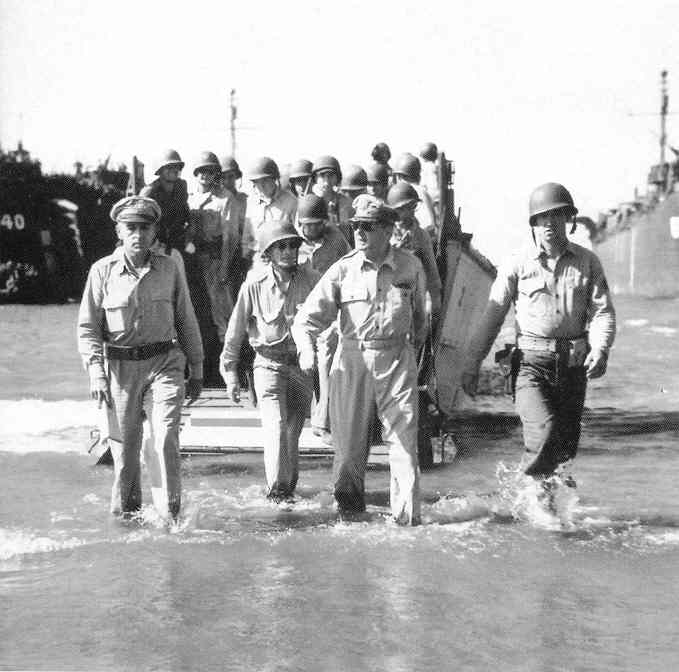
Douglas MacArthur returns
to the Philippines – October 1944
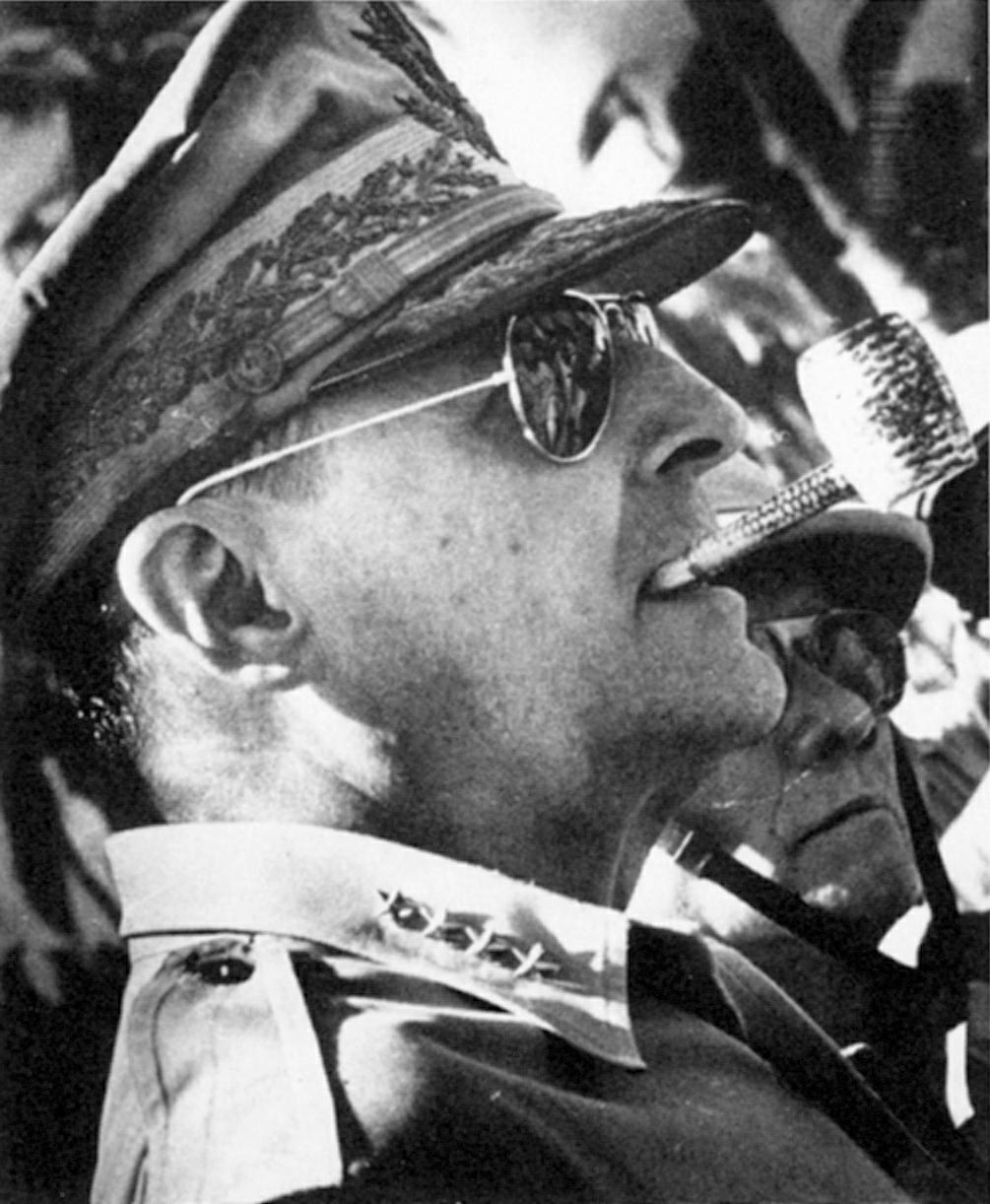
"General
MacArthur surveys
the beachhead on Leyte Island, soon after
American forces swept ashore
from a gigantic liberation armada into the central Philippines,
at the historic moment when
the General made good his promise 'I shall return.'" 1944.
National
Archives
"Veteran Artillery men of the `C' Battery,
90th Field Artillery, lay down a murderous barrage
on troublesome Jap artillery
positions in Balete Pass, Luzon, P.I." Morton, April 19, 1945.
National Archives
111-SC-205918.
Meanwhile, America is stepping up its direct attacks on Tokyo
"Pilots aboard a U.S. Navy aircraft
carrier receive last minute instructions before taking off
to attack industrial, and military
installations in Tokyo." February 17, 1945.
National Archives
208-N-38374
Iwo Jima
"Marines of the 5th Division inch their
way up a slope on Red Beach No. 1 toward Surbachi
Yama as the smoke of the battle drifts about
them." Dreyfuss, Iwo Jima, February 19, 1945.
National Archives
127-N-110249.
"Across the litter on Iwo Jima's black
sands, Marines of the 4th Division shell Jap positions
cleverly concealed back from the beaches.
Here, a gun pumps a stream of shells
into Jap positions inland on the tiny
volcanic island." ca. February 1945.
National Archives
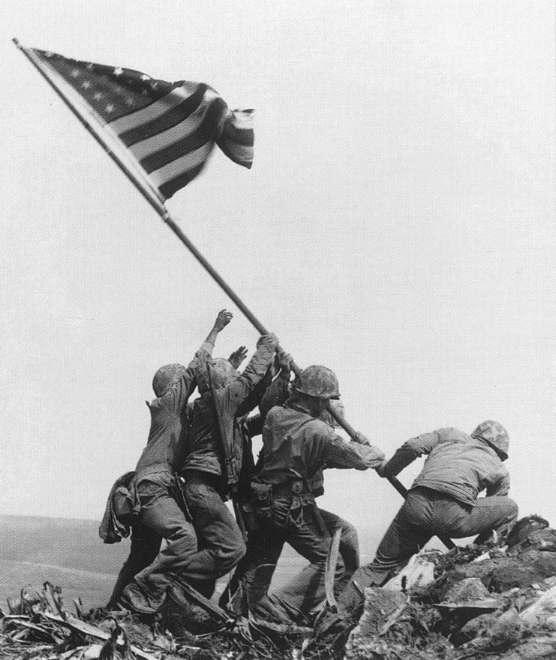
U.S. troops
raising
the American flag on Mt. Suribachi on Iwo Jima – February 23,
1945
U.S. National Archives
80-G-413988
U.S. troops
raising the American
flag on Mt. Suribachi on Iwo Jima (sequel
picture)
"Smashed by Jap mortar and shellfire,
trapped by Iwo's treacherous black-ash sands,
amtracs
and other vehicles of war lay knocked
out on the black sands of the volcanic
fortress."
PhoM3c. Robert M. Warren, ca. February/March
1945.
National Archives
26-G-4474
Kamikaze!

The briefing of
Kamikaze
pilots
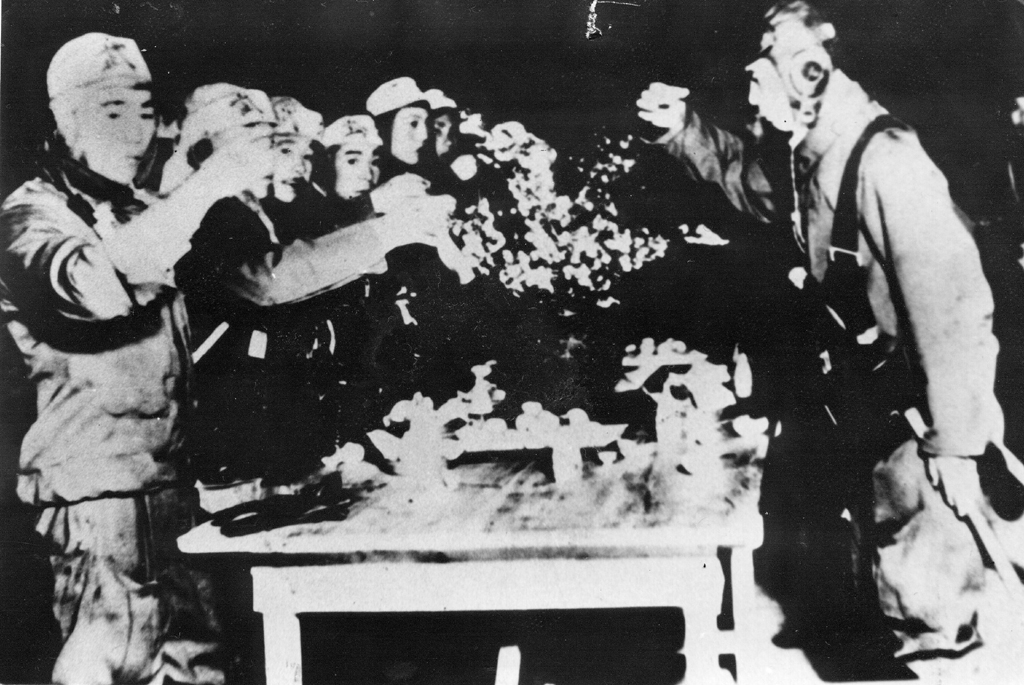
The last ritual of
the Kamikaze
pilots
worldwar42.blogspot.com
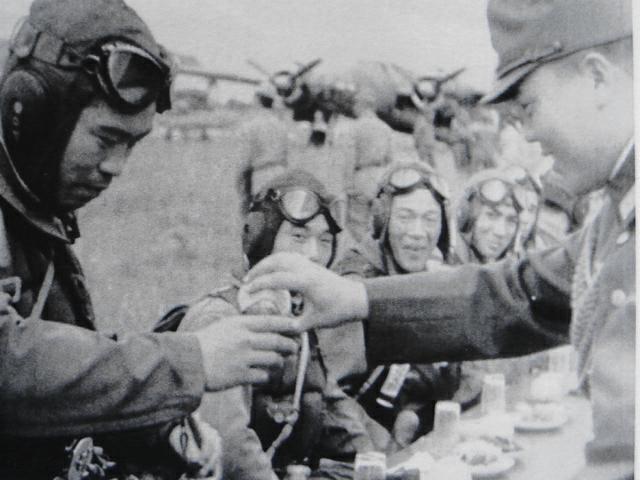
Saki for the
Kamikaze
pilots
worldwar42.blogspot.com
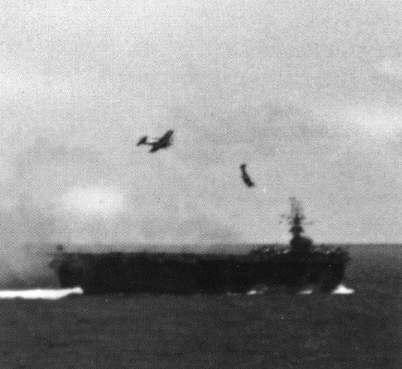
Kamikazes
attacking
a US carrier
The
American aircraft
carrier Belleau Woods hit by a kamikaze
bomber
U.S. Navy
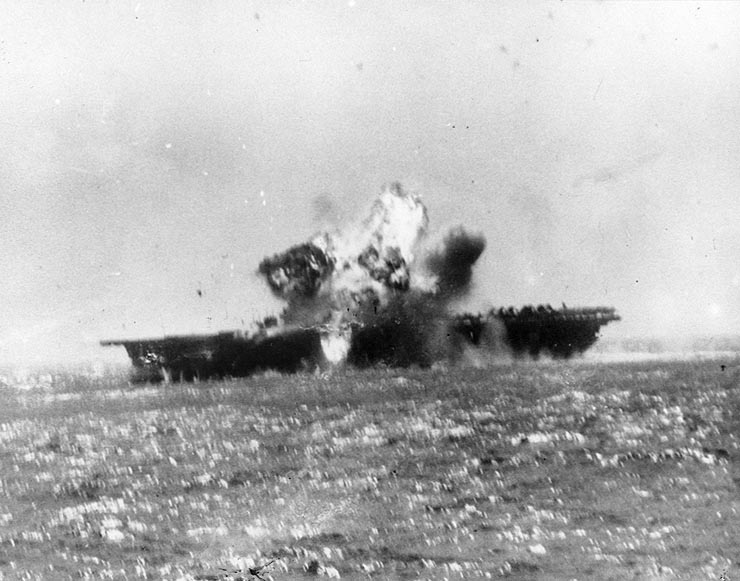
USS Essex is hit
by Kamikaze
- 25 November 1944
U.S. Naval Historical
Center
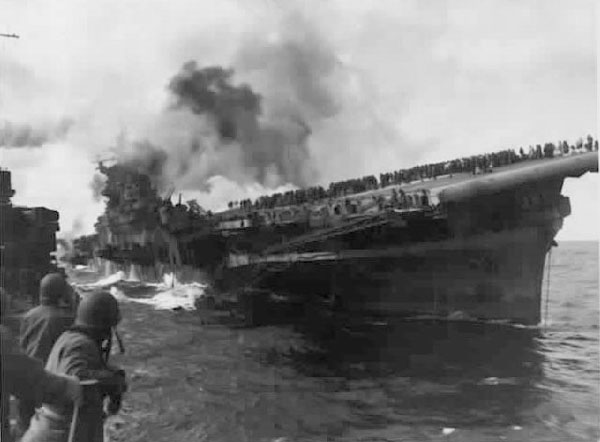
Aircraft carrier
USS Franklin,
hit by 2 Kamikazes, sinks – March 1945
U.S. National Archives,
Wash. D.C.
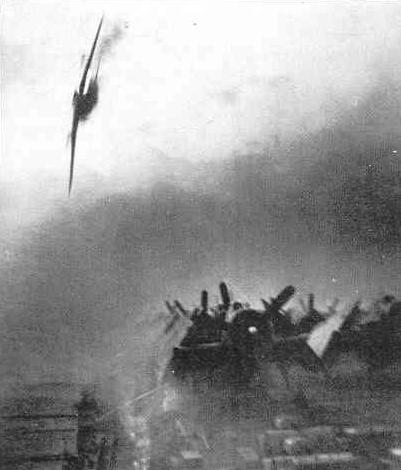
A Kamikaze
plane misses crashing
into the U.S.S. Sangamon
National Archives
"USS Bunker Hill hit by two Kamikazes
in 30 seconds on 11 May 1945 off Kyushu.
Dead-372. Wounded-264."
National Archives
80-G-323712
"USS Bunker Hill hit by two
Kamikazes
National Archives
"Transfer of wounded from USS Bunker HIll to USS Wilkes Barre, who were injured
during fire aboard carrier following
Jap suicide dive bombing attack off Okinawa."
PhoM3c. Kenneth E. Roberts, May 11,
1945.
National Archives
80-G-328610
Okinawa
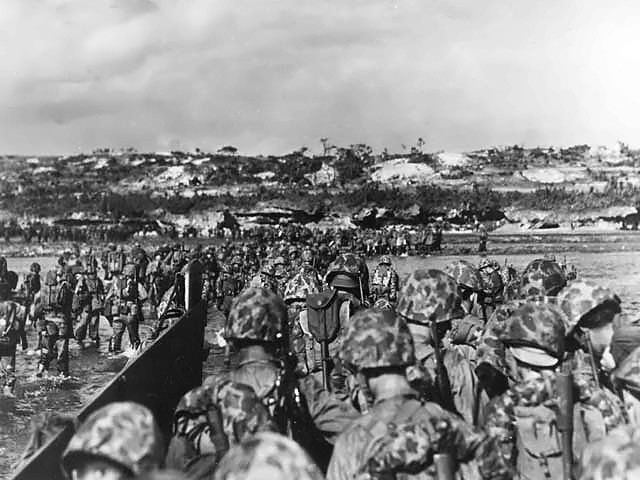
Marines of the
US 10th Army
in camouflage battle dress storm out of a landing craft
to establish a beachhead, March 31, 1945
on Okinawa, largest of the Ryukyu
(Loochoo) Islands, 375 miles from
Japan.
National Archives,
39573-FMC
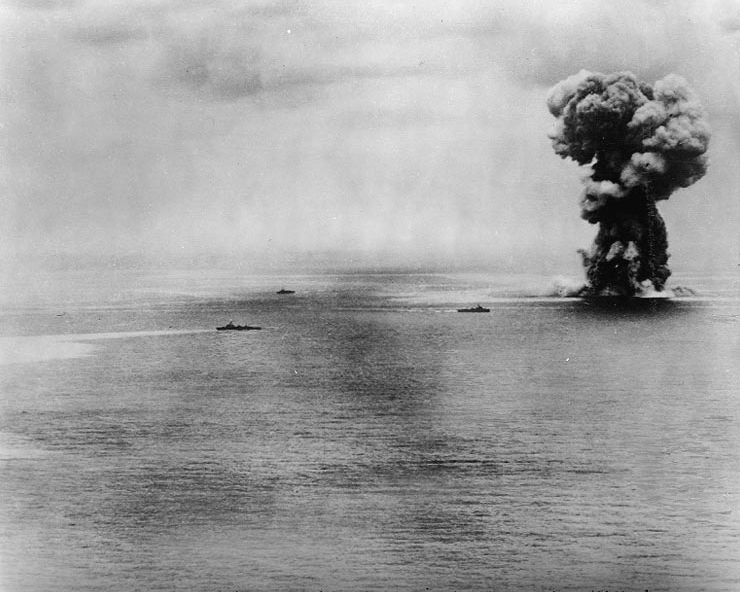
Japanese
battleship Yamato
blows up after receiving massive bomb and torpedo damage from
U.S. Navy carrier planes,
north of Okinawa on 7 April 1945. Three Japanese destroyers are
nearby.
US Navy – National
Archives
Flushing out Japanese troops with napalm on Okinawa – April 1945
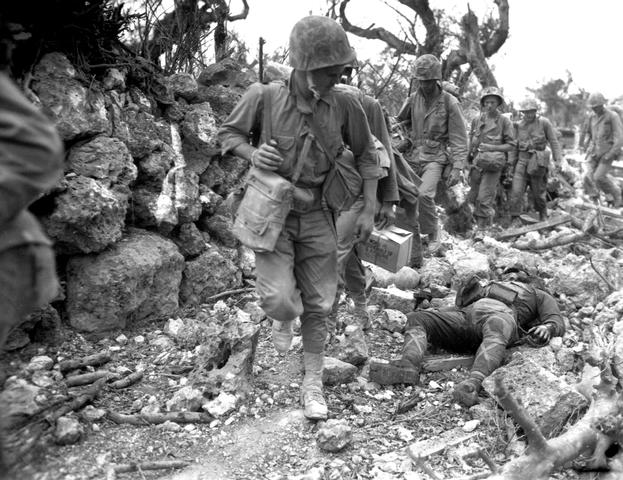
Marines pass through a small
village where a Japanese soldier lies dead.
Okinawa, April 1945. Norris
G. McElroy.
National Archives
127-N-95-119485
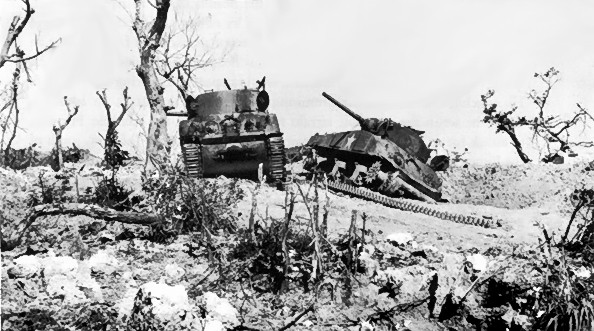
The attack on
bloody ridge
of 20 April was marked by severe fighting.
During the fighting on Bloody
Ridge two medium tanks were knocked out
by Japanese artillery fire
from the Pinnacle.
US
Army
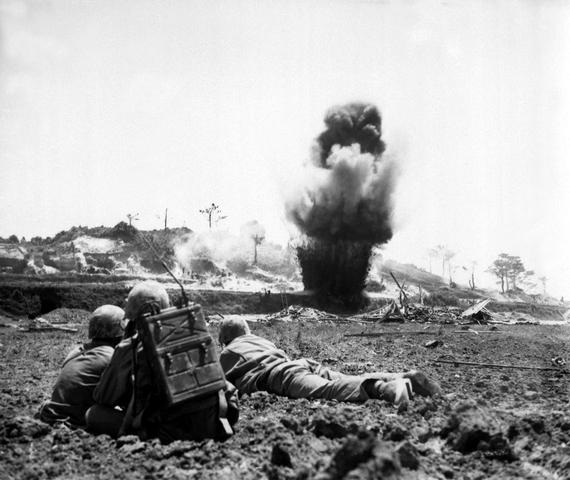
A demolition
crew from the
6th Marine Division watch dynamite charges explode
and destroy a Japanese cave.
Okinawa, May 1945.
National Archives,
127-N-122154
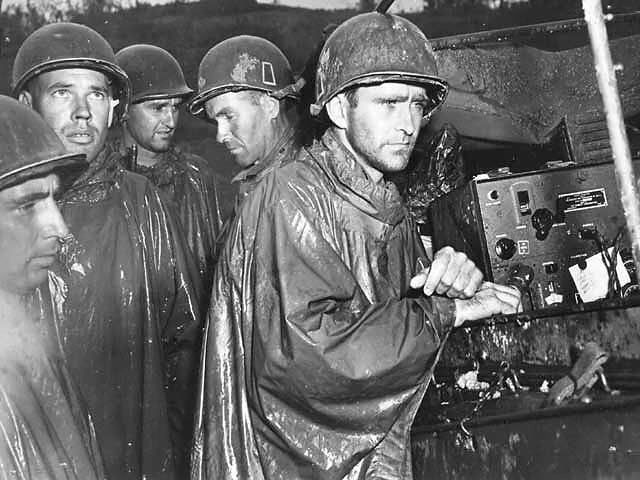
A few yards
behind the front
lines on Okinawa, fighting men of the US Army's 77th
Infantry division listen
to radio reports of Germany's surrender on May 8,
1945.
| "Their battle hardened faces indicate the impassiveness with which they received the news of the victory on a far distant front. One minute after this photo was taken, they returned to their combat post. Officially however, American forces on Okinawa celebrated the end of the war in Europe by training every ship and shore battery on a Japanese target and firing one shell simultaneously and precisely at midnight." |
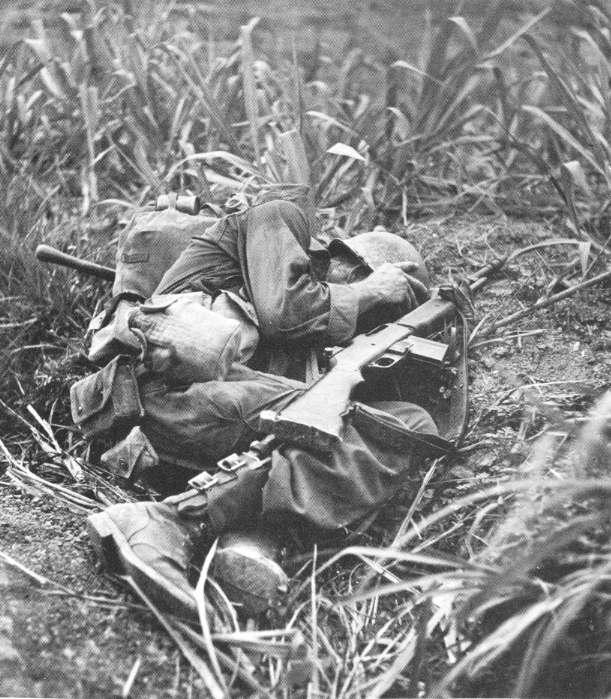
A GI under fire
at
Okinawa
"A Marine of the 1st Marine Division
draws a bead on a Japanese sniper with his
tommy-gun
as his companion ducks for cover. The
division is working to take
Wana Ridge
before the town of Shuri." S.Sgt. Walter
F. Kleine, Okinawa, 1945.
National Archives
127-N-123170
"With the captured capital of Naha as
a background, Marine Maj. Gen. Lemuel Shepherd,
commanding general of the 6th Marine
Division, relaxes on an Okinawan ridge long enough
to consult a map of the terrain." Pfc.
Sam Weiner, ca. June 1945.
National Archives
127-GR-95-122119
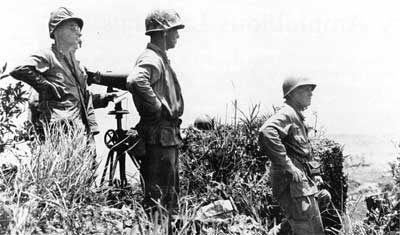
Lt. Gen Simon B.
Buckner,
Jr., USA, right, observing the 8th Marines in action on Okinawa
for the first time since
the regiment entered the lines in the drive to the south.
This is the last photograph
taken of him before he was killed on 19 June.
National Archives,
127-N-122154
"Corsair fighter looses its load of
rocket projectiles on a run against a Jap stronghold on
Okinawa. In the lower background is the smoke
of battle as Marine units move in to
follow up
with a Sunday punch." Lt. David D.
Duncan, ca. June 1945.
National Archives
127-GR-97-126420
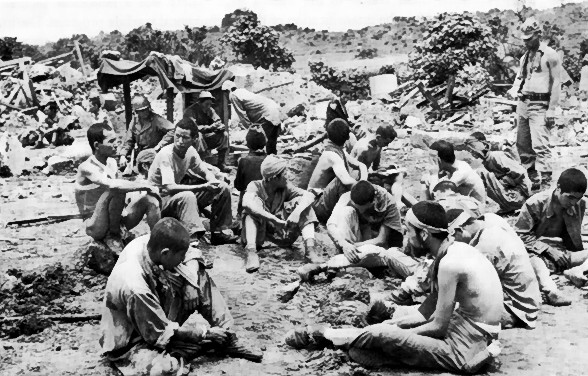
A group of
Japanese prisoners
who preferred capture to suicide.
They are waiting to be
questioned
by American officers.
US Army
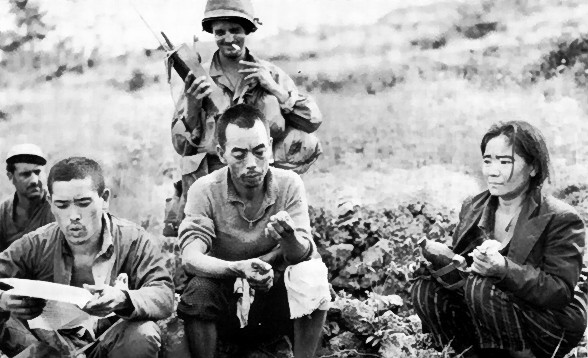
Overcoming the
last resistance
on Okinawa was aided by propaganda leaflets,
one of which is being read
by a prisoner awaiting transportation to the rear.
Many civilians gave up at
the same time.
US Army
And the direct bombing attacks on Tokyo and Japan step up in intensity
"Tokyo burns
under B-29 firebomb
assault." May 26, 1945
Library of Congress
Charred remains
of Japanese
civilians after the 10 March 1945 firebombing of Tokyo
Ishikawa Koyo
"Task Force 58
raid on Japan.
40mm guns firing aboard USS Hornet on 16 February
1945,
as the carrier's planes
were raiding Tokyo." Lt. Comdr. Charles Kerlee, February
1945.
National Archives
80-G-413915
"USS ESSEX-based TBMs and
SB2Cs dropping bombs on Hokadate (Hakodate), Japan."
July
1945.
National Archives
80-G-490232
Japanese training for home defense in anticipation of American invasion of Japan - 1945

|
|
At the very beginning of its offensive in December of 1941, Japan and its ally Thailand had attacked British Burma (today's Myanmar) and by April of 1942 had forced the British out of its colony there. The Chinese meanwhile were largely holding the line against Japanese expansion in China, and were even able to come to the aid of British troops in Burma, which had found themselves surrounded by Japanese troops. Then from their position in Burma, in March of 1944 the Japanese attempted a new offensive against the Allies by attacking the British position in Assam (northeast India) which the Allies had been using as a base to fly supplies across the mountainous hump into China. To counter the Japanese, India itself provided over three million troops to the Allied cause, some of the most dedicated soldiers in the Allied cause. Gandhi and the INA
Strangely, it was at this desperate time for
India that Mohandas (or Mahatma – the "Great Soul") Gandhi decided it
was an opportune moment to disrupt British governance of India in order
to achieve his long-standing dream of getting Britain to "Quit India."
He was joined in this effort by a former ally (with whom he had earlier
parted ways), the young Subhas Chandra Bose – who had assembled an army
of British-haters, willing as the Indian National Army (INA) even to
join the Japanese in fighting not only the British in northeastern
India but also the multitude of Indians serving in the British Army. Ultimately nothing came of either effort. The Indians did not show great interest in Gandhi’s attempt to make India ungovernable, especially in the face of a Japanese threat, the Indians being generally very well aware of how horribly the Japanese treated non-Japanese. And the INA did not do well against the heavily Indian-staffed British Army, nor did their Japanese allies, thus ending the Japanese threat to India – and the dreams of glory of the INA. However, Gandhi was subsequently arrested – which did finally stir Indian wrath.
|
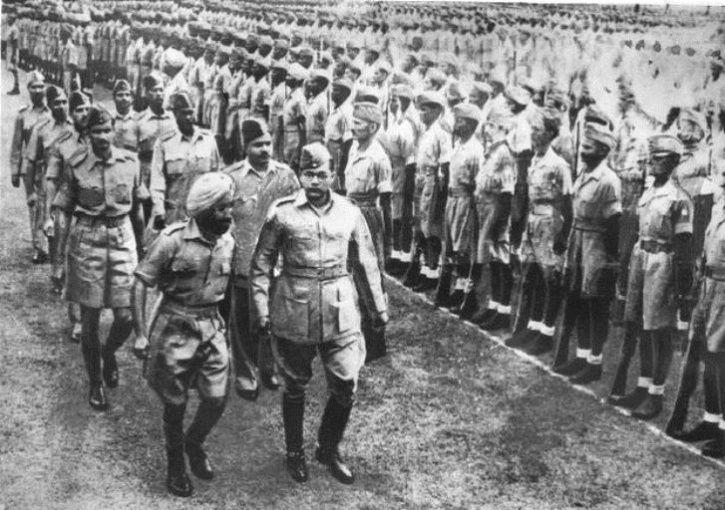
Bose inspecting his Indian National Army
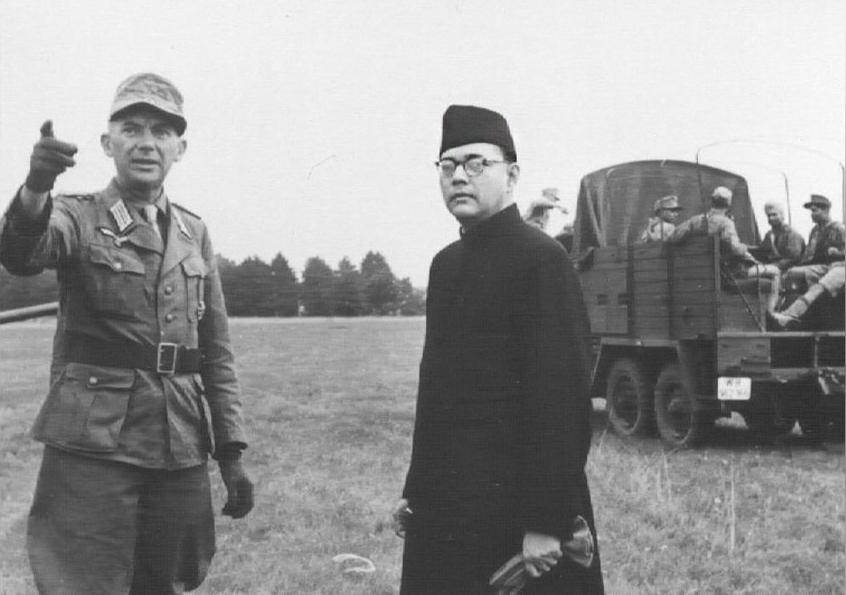
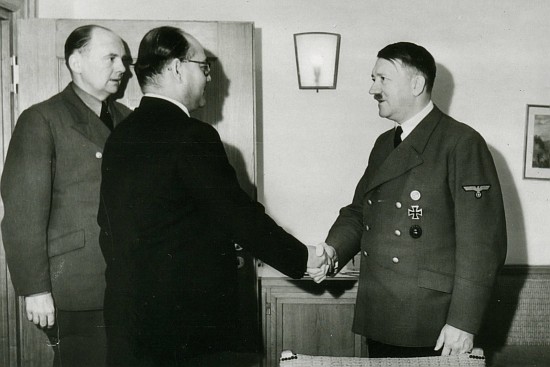
Bose with a German officer ... and with Hitler
When Hitler seemed unresponsive to Bose's offer of alliance of his INA with
Germany, Bose turned to the Japanese ... who played along with his offer.
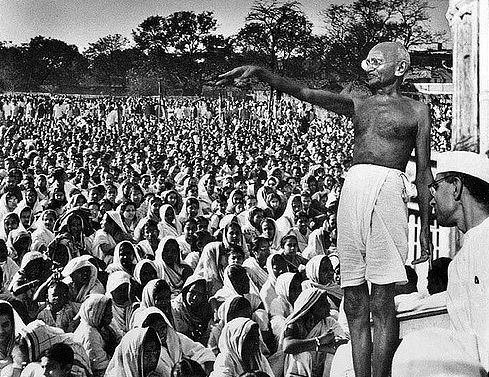
Gandhi announcing his "Quit India Movement" designed to oust the British
(and their culture) from India
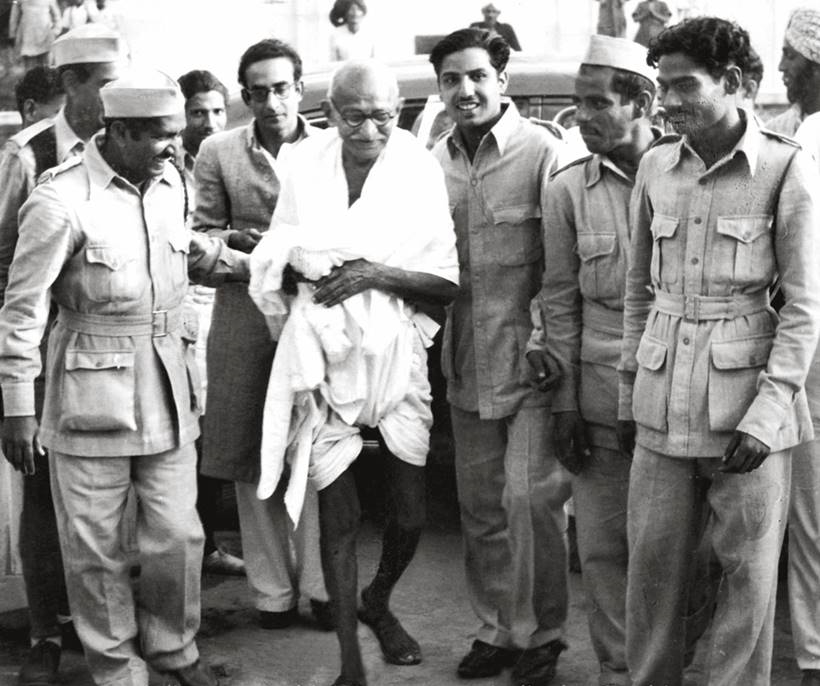
Gandhi with INA soldiers at the INA Trials – 1945
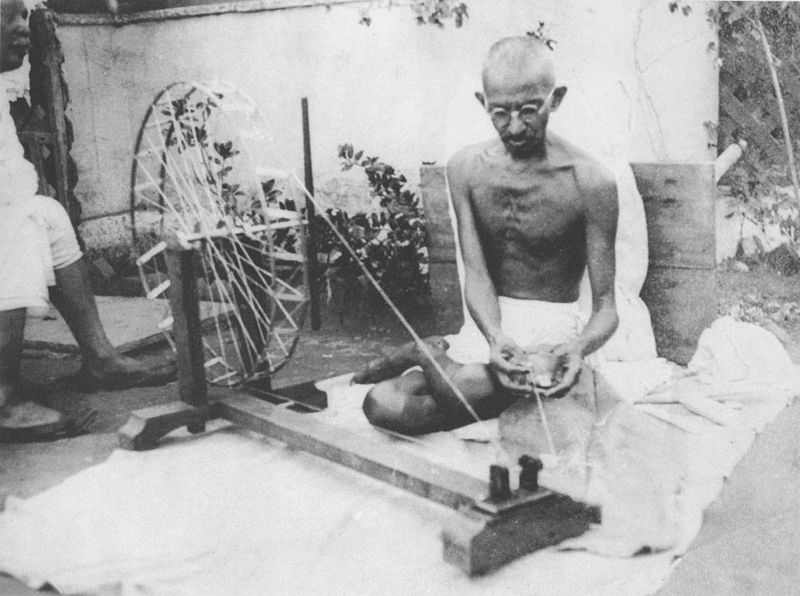
Gandhi's answer to the British-introduced industrial revolution
was to go back to ancient Indian ways
... which, had India done so, would foolishly have caused the population to starve
back to its pre-British population size of about half of the then-current population.
"U.S. Convoy which operates between
Chen-Yi and Kweiyang, China, is ascending
the famous twenty-one curves at Annan,
China." Pfc. John F. Albert, March 26, 1945.
National Archives,
111-SC-208807


 Miles
H. Hodges
Miles
H. Hodges